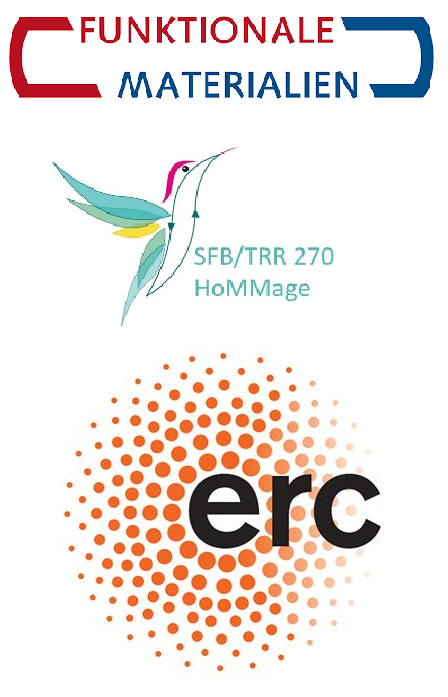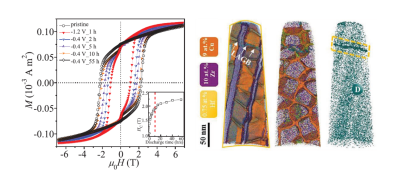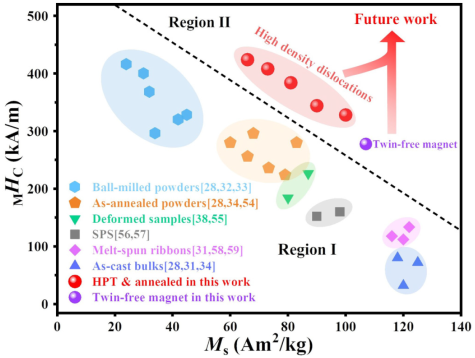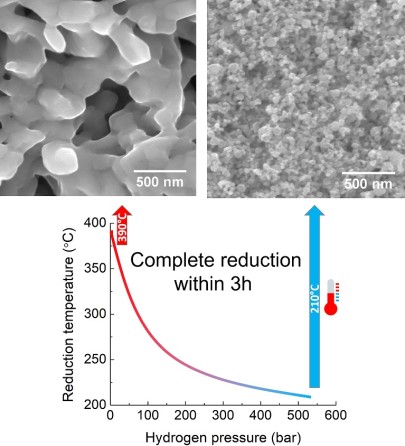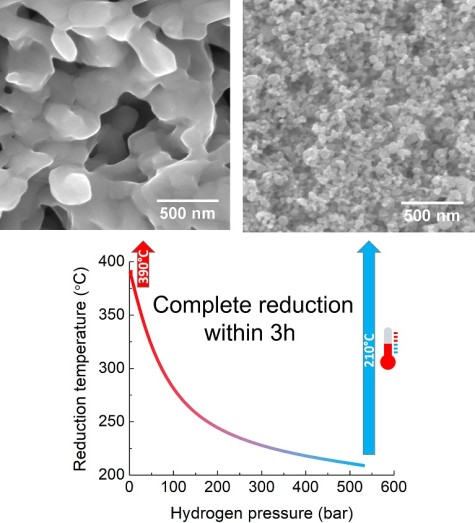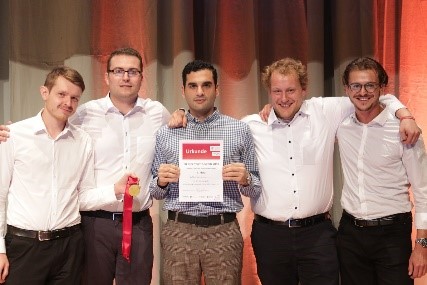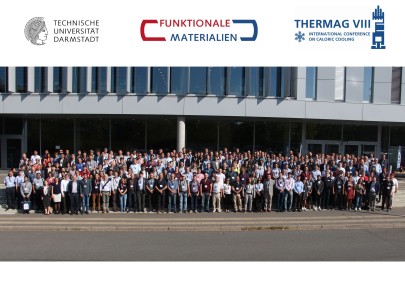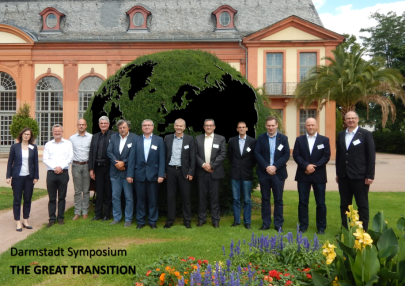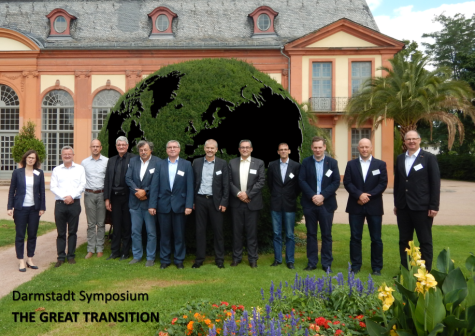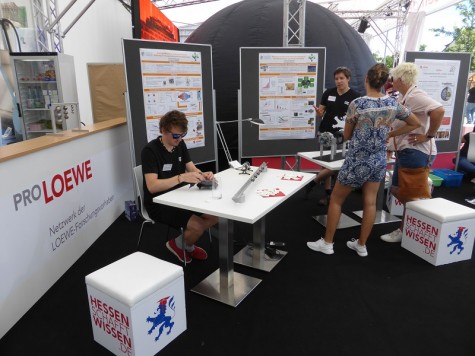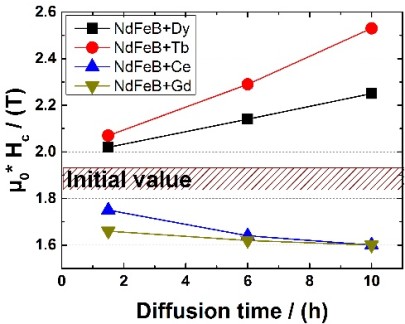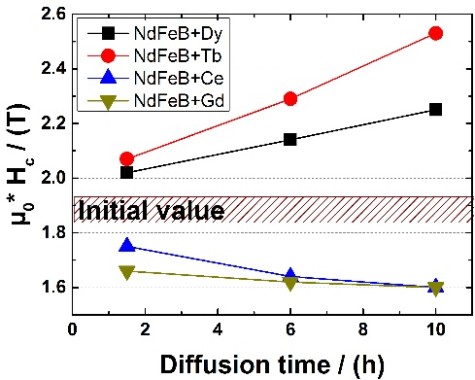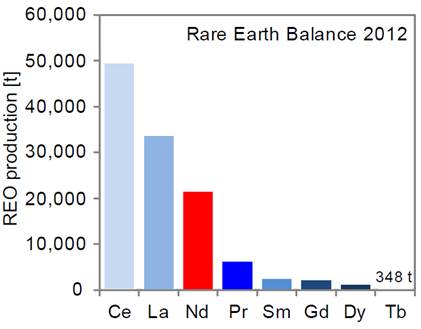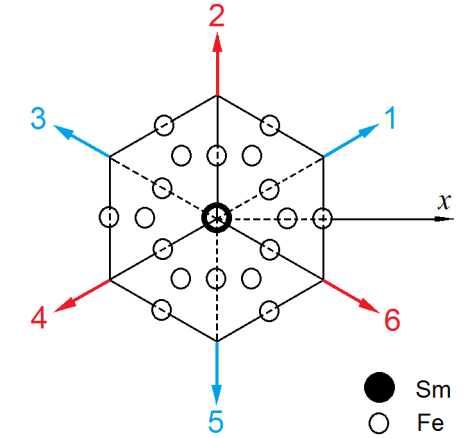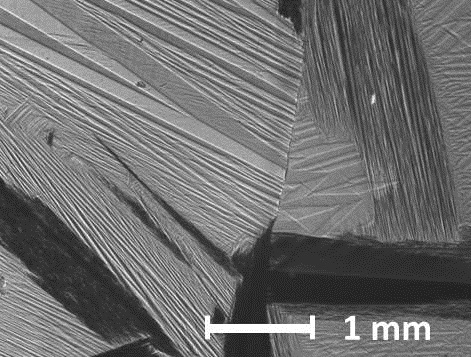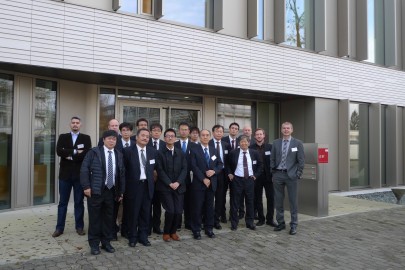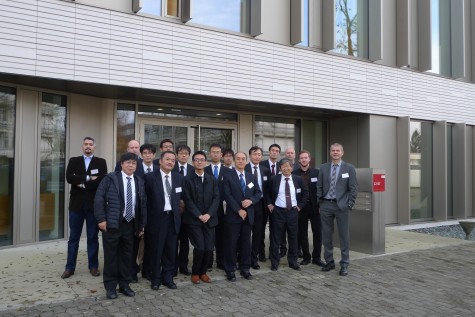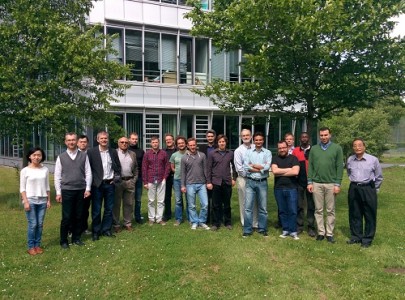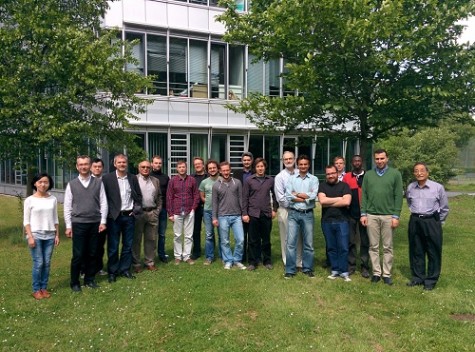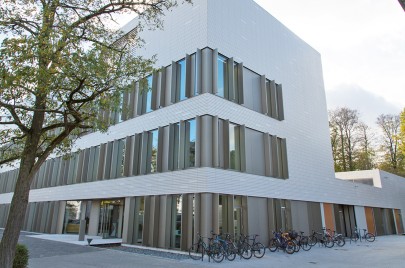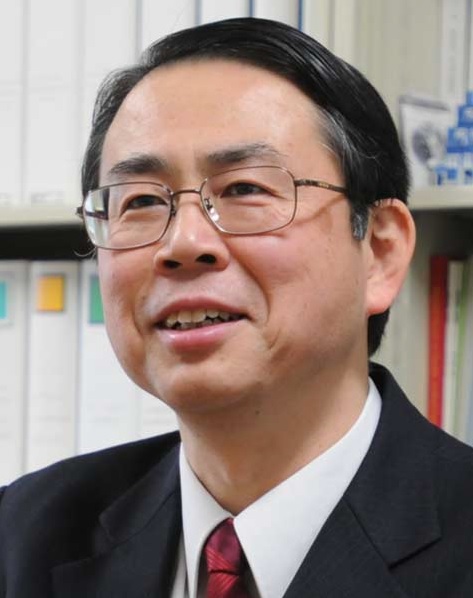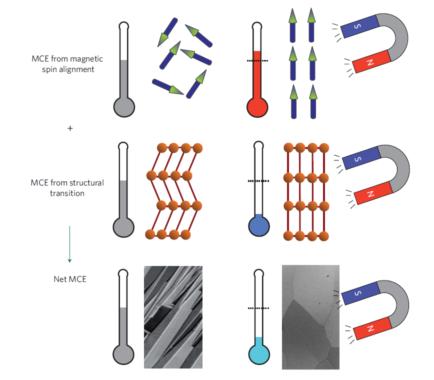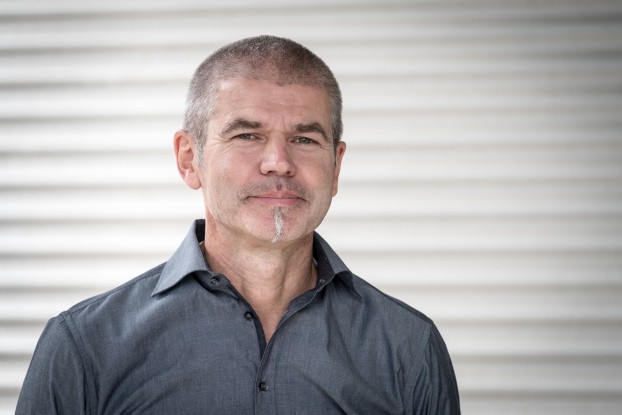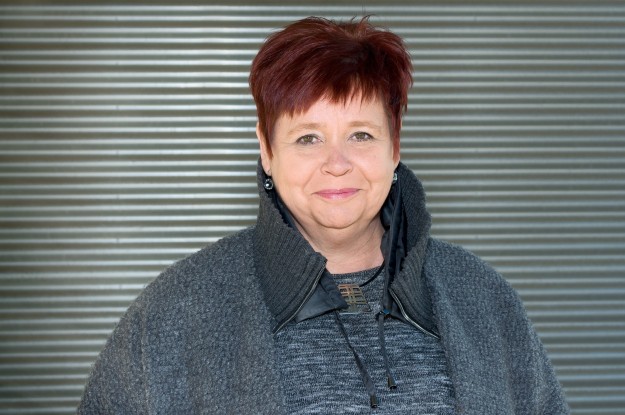Welcome to Functional Materials
Human development has caused a depletion of natural energy and mineral resources and climate changes with non-predictable consequences. New energy concepts are required for the future of our industrial society resulting in e.g. an ever increasing emphasis on improving the efficiency of electricity transmission and utilization and in the progressive replacement of oil-based fuels in transportation by electric motors. Efficient cooling is another important challenge for our society. Humanity worried about keeping warm, now we will have to invest heavily into cooling as a basic necessity. In this context, Material Science has to make a major contribution.
We work on novel permanent and soft magnets, magneto- and elastocaloric and magnetostrictive materials as well as magnetic shape memory alloys and more generally on materials for efficient energy storage, transportation and conversion. They can enable a drastic and rapid reduction in CO2 emissions from the burning of fossil fuels or from the use of conventional refrigerants.
The development of new earth abundant materials for renewable energy technologies operating much closer to their physical limits requires novel processing routes, modelling on all length scales and advanced characterization techniques with high time and spatial resolution. We develop principle material design strategies and descriptors combined with high-throughput techniques by simulation and experiment. Additive manufacturing enables us to tailor and integrate local and sensing functionalities into devices and explore the concept of cyber-physical twins.
The great energy transformation is also a material´s transformation (“Die Energiewende ist eine Materialwende”). We study the reduction, substitution and recycling of critical materials on element, process and product levels as demand for strategic elements will multiply in the near future. Our graduates will be Material Science experts in this challenging field of research.
Oliver Gutfleisch
Most Recent Highlights
Magnetoelectric Tuning of Pinning-Type Permanent Magnets through Atomic-Scale Engineering of Grain Boundaries
X. Ye, F. Yan, L. Schäfer, D. Wang, H. Geßwein, W. Wang, M. R. Chellali, L. T. Stephenson, K. Skokov, O. Gutfleisch, D. Raabe, H. Hahn, B. Gault, and R. Kruk
Adv. Mater. 2020, 2006853
DOI: 10.1002/adma.202006853
Pinning-type magnets with high coercivity at high temperatures, especially Sm2Co17-type magnets, are at the core of thriving clean-energy technologies. Despite intensive efforts to optimize the intragranular microstructure, the coercivity currently only reaches 20–30% of the theoretical limits. In our recent work with the Karlsruhe Institute of Technology and Max-Planck-Institut für Eisenforschung the coercivity in commercial Sm2Co17 magnets is reversibly tuned by an unprecedented value of ≈1.3 T through hydrogen charging/discharging by applying voltages of only ≈1 V. Combining magnetic measurements, in situ magneto-structural characterization and atomic-scale tracking of hydrogen (deuterium) atoms reveal that the segregation of hydrogen atoms at the grain boundaries, rather than the change of the crystal structure, dominates the reversible and substantial change of coercivity. This study reveals importance of grain boundaries in the conventional magnetization switching paradigm of pinning-type magnets, suggesting a critical reconsideration of engineering strategies to overcome the coercivity limits.
Intrinsically weak magnetic anisotropy of cerium in potential hard-magnetic intermetallics
A. Galler, S. Ener, F. Maccari, I. Dirba, K. P. Skokov, O. Gutfleisch, S. Biermann and L. V. Pourovskii
npj Quantum Materials 6, 2 (2021)
DOI: 10.1038/s41535-020-00301-6
Ce-based intermetallics are interesting for hard magnetic compounds; utilizing rare-earth balanced material systems could help to mitigate shortcomings in the supply of rare earth resources due to the monopolistic market and growing demands. For various Ce intermetallics like CeFe2, RE2Fe14B and RECo5 a heavy-fermion behavior is reported where the Ce local magnetic moment is screened by conduction electrons. In our recent work in cooperation with the École Polytechnique, we focus on the CeFe11Ti system and investigate the Kondo effect on the magnetic properties of ternary CeFe11Ti and nitrogenated (CeFe11TiNx) samples. An ab initio approach to the magnetocrystalline anisotropy of Ce-based intermetallics nitrogen shows that interstitials suppress effectively the Ce-4f contribution to the magnetic anisotropy.
KIC UPGRADE Project in EIT Raw Materials Newsletter
In the Newsletter of EIT Raw Materials the project UPGRADE – Optimised process for new permanent magnet grades with low content of heavy rare earth, of which functional materials is also part of, is presented.
The ambition of the project is to fully exploit the large potential of the strip-cast-process for HRE–lean magnet grades. The achievements will boost development of fine-grained Nd-Fe-B alloys. Additionally, it will allow the extension of the conventional manufacturing processes beyond their current limits. With a growing demand for Electrical Vehicles, requiring a high amount of HRE in high temperature applications, the market potential for the innovative process is high. The international consortium including research institutes and alloys supplier, a magnet manufacturer and an end-user for assessment represents the complete value chain of the magnet industry.
We congratulate our colleague Andreas Taubel to his very successfull PhD defense. His thesis has the title “Designing Multicaloric Materials with Martensitic Phase Transitions for Future Cooling Applications” and was evaluated with destinction. The traditional celebrations in our group had to be adapted to corona regulations and were carried out outside with distance and virtually.
We thank Andreas for his dedicated work in the last years and wish him all the best for his future career. As a start we are very happy, that he will continue his work as a post doc in our group.
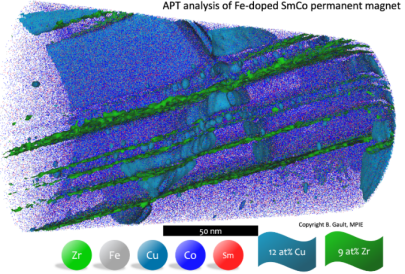
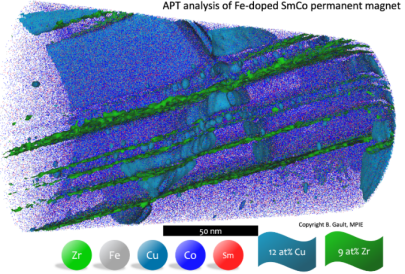
New Max Planck Research Group headed by Prof. Oliver Gutfleisch to study magnets as key materials for green energy
New collaboration between TU Darmstadt and Max-Planck-Institut für Eisenforschung (MPIE)
The Technical University of Darmstadt and the Max-Planck-Institut für Eisenforschung (MPIE) started a new Max Planck Research Group headed by Prof. Oliver Gutfleisch, Professor of Functional Materials at the TU Darmstadt and scientific director at the Fraunhofer IWKS Materials Recycling and Resource Strategies.
The group is established at the MPIE and deals with the design of advanced hard and soft magnets, magnetocaloric and related functional materials. (text by MPIE / pg)
Read more https://www.tu-darmstadt.de/universitaet/aktuelles_meldungen/einzelansicht_277312.en.jsp
Giant voltage-induced modification of magnetism in micron-scale ferromagnetic metals by hydrogen charging
Xinglong Ye, Harish K. Singh, Hongbin Zhang, Holger Geßwein, Mohammed Reda Chellali, Ralf Witte, Alan Molinari, Konstantin Skokov, Oliver Gutfleisch, Horst Hahn & Robert Kruk
Nature Communications, 11, 4849 (2020)
https://doi.org/10.1038/s41467-020-18552-z
Magnetic properties of micron-scale ferromagnetic metals can be modulated substantially through electrochemically-controlled insertion and extraction of hydrogen atoms in metal structure. Together with our colleagues from Karlsruhe Institute of Technology, we employed magneto-ionics technique to control the hard magnetic properties of micrometer-sized SmCo5 powder. We showed that it is possible to reversibly charge and discharge the material with hydrogen atoms by applying small voltages of only ~ 1 V. Using this approach, the coercivity of SmCo5 powder was tuned by ~1 T, that is more than two orders of magnitudes larger than previously achieved in ultrathin films by charge doping and magneto-ionics. Moreover, voltage-assisted magnetization reversal was demonstrated at room temperature. Thus, our study opens up a way to control the magnetic properties in ferromagnetic metals beyond the electric-field screening length, paving its way towards practical use in magneto-electric actuation and voltage-assisted magnetic storage.
Masken gegen Corona und für gute Laune
Wie kann man Infektionen am Arbeitsplatz vermeiden? Ganz einfach, die AHA+L Regeln einhalten. Herkömmliche Einmalmasken stehen den MitarbeiterInnen des Fachgebietes Funktionale Materialien seit Anfang der Pandemie zur Verfügung. Eine stylishe Alternative bieten nun die selbst genähten Masken von Frau Laux, der Sekretärin des Fachgebietes. Sie näht die Masken in ihrer Freizeit in verschiedenen Größen und mit den unterschiedlichsten Designs, sodass für jeden eine dabei war. Die Masken stehen der Gruppe kostenlos zur Verfügung und waren sofort vergriffen.
Aufgrund der großen Nachfrage, ist die nächste FM-Maskenserie bereits in Vorbereitung, dieses Mal mit weihnachtlichen Motiven. So kann der Maskenpflicht auch an Weihnachten stylish nachgekommen werden und die Stimmung bleibt gut. (Foto: die Kolleginnen Laux und Kaiser mit unserer Azubi Jacqueline Hoffmann bei der Verteilung)
Nanocrystalline Sm-based 1:12 magnets
A.M. Schönhöbel, R. Madugundo, J.M. Barandiarán, G.C. Hadjipanayis, D. Palanisamy, T. Schwarz, B. Gault, D. Raabe, K. Skokov, O. Gutfleisch, J. Fischbacher, T. Schrefl
Acta Materialia 200, 652 (2020)
https://doi.org/10.1016/j.actamat.2020.08.075
Recently 1:12 magnets of Sm-(Fe,V) have shown promising coercivities and the potential for alternative rare-earth-lean permanent magnets. However, to enable practical applications, alloys with exquisite intrinsic properties need to be transformed into bulk magnets with extrinsic properties, i.e. coercivity and remanence, by optimizing the microstructure.
In this collaborative international research effort, we investigated the effects of partial substitution of Cu, Mo and Ti for V in the magnets prepared by hot compaction and hot deformation of mechanically milled powders. The Sm-Fe-(V,Cu) magnet showed the best performance with μ0Hc=0.96 T, μ0Mr=0.49 T, (BH)max=42 kJm−3 and TC=362°C. Atom probe tomography of this magnet revealed that an addition of a small amount of Cu not only improved the magnetic properties but also hindered the grain growth during hot deformation. Micromagnetic simulations reveals that the presence of the intergranular phase reduces the number of grains that switch simultaneously.
Editor´s choice: L10 rare-earth-free permanent magnets: The effects of twinning versus dislocations in Mn-Al magnets
Yuxiao Jia, Yuye Wu, Shuang Zhao, Shulan Zuo, Konstantin P. Skokov, Oliver Gutfleisch, Chengbao Jiang, and Huibin Xu
Phys. Rev. Materials 4, 094402 (2020)
DOI:https://doi.org/10.1103/PhysRevMaterials.4.094402
The understanding of the coercivity mechanism responsible for hard magnetic properties of MnAl L10 alloys is still unsatisfactory. The role of microstructural features, such as twinning structure, dislocations and antiphase boundaries in the formation of the highly coercive state is still controversial.
In this paper, in cooperation with Beihang University, Beijing, China, we report on (1) the “negative” effect of twin structure and (2) the “positive” effect of dislocations on the coercivity of L10-MnAl alloys. Based on a comparison between the twin-free and twinned magnets, we have shown that twin boundaries act as initial nucleation sites of the reversal magnetic domains and reduce the coercivity by 50%. In contrast, dislocations formed by high pressure torsion act as a “strong” pinning centers of domain wall motion, increasing the coercivity up to 424 kA/m. Thus, the combination of (1) eliminating twin structure and (2) introducing high-density dislocations will overcome the present bottleneck in magnetic performance of MnAl L10 alloys and set up a pathway to accelerate an industrial application of these resource efficient Rare-Earth-free permanent magnets.
Synthesis and magnetic properties of bulk α″-Fe16N2/SrAl2Fe10O19 composite magnets
I. Dirba, M. Mohammadi, F. Rhein, Qihua Gong, Min Yi, B.-X. Xu, M. Krispin, O. Gutfleisch
Journal of Magnetism and Magnetic Materials 518 (2021) 167414
https://doi.org/10.1016/j.jmmm.2020.167414
This work id a result of collaboration with the Mechanics of Functional Materials Division at the TU Darmstadt and Siemens AG, Corporate Technology. In the quest for hard-soft composite magnets, we present here the interesting case of mixing iron nitride and Sr-hexaferrite, where the uniaxial anisotropy of the ‘soft’ phase is larger than that of the hard phase. We have synthesized bulk hard-soft composite magnets from Al-doped Sr-hexaferrite SrAl2Fe10O19 sub-micron- and iron nitride α″-Fe16N2 nano-particles. Both powders have been mixed via ball milling, followed by compaction at low temperatures.
Determination of the crystal field parameters in SmFe11Ti
L. V. B. Diop, M. D. Kuz’min, Y. Skourski, K. P. Skokov, I. A. Radulov, O. Gutfleisch
Physical Review B 102, 064423 (2020)
DOI:10.1103/PhysRevB.102.064423
SmFe11Ti is an interesting material not only from an application point of view as a permanent-magnet material, but also from a fundamental perspective as a model system for studying magnetic anisotropy and crystal fields. However, the few reports on the crystal field parameters of SmFe11Ti are all based on fitting a single magnetization curve.
Here, the magnetization of SmFe11Ti single crystals has been measured along the principal crystallographic directions in steady (14 T) and pulsed (43 T) magnetic fields. The fourfold symmetry axis [001] is an easy magnetization direction. The magnetization curves measured in directions perpendicular to [001] are remarkable in two ways: (i) They do not depend on orientation of H within the basal plane; (ii) at low temperature they are S shaped, with an inflection point at about 0.6 times saturation magnetization. These two facts enable us to conclude that three out of five crystal field parameters of SmFe11Ti are negligibly small; only A02 and A06 are essentially nonzero. A comparison with an isomorphous compound DyFe11Ti reveals a dramatic disparity of their crystal fields, especially as regardsA44, nearly zero in SmFe11Ti but outstandingly large in DyFe11Ti.
Production of Fe nanoparticles from γ-Fe2O3 by high-pressure hydrogen reduction
I. Dirba, C.A. Schwöbel, A. Zintler, P. Komissinskiy, L. Molina-Luna, O. Gutfleisch
Nanoscale Adv. (2020). doi:10.1039/D0NA00635A.
This work is a result of our fruitful, synergistic collaborations within the Materials Science department, namely, with researchers from the Advanced Thin Film Technology and Advanced Electron Microscopy groups.
We have demonstrated that by increasing the hydrogen pressure up to 530 bar, it is possible to lower the temperature necessary for complete reduction of γ-Fe2O3 nanoparticles to α-Fe from 390 °C down to 210 °C. This significant improvement in reduction temperature was shown to be beneficial for the final particle morphology. Coalescence and sintering of the particles accompanied by surface area loss which occurs at elevated temperatures can be suppressed when reduction is performed at 210 °C. Interestingly, coercivity even exceeds the theoretical anisotropy field for these particles. TEM investigations reveal that the Fe nanoparticles are passivated with a Fe2O3 layer resulting in a core–shell structure.
These findings are relevant for applications such as catalysis and exchange-coupled nanocomposites, where fine iron nanoparticles with high surface area are required. The presented method can be extended to other metal-oxide systems.
“Greener Society”: Magnetocaloric effect in GdNi2 for cryogenic gas liquefaction studied in magnetic fields up to 50 T
Author: Sergey Taskaev, Vladimir Khovaylo, Konstantin Skokov, Wei Liu, Eduard Bykov, Maxim Ulyanov, Dmitriy Bataev, Anastasiya Basharova, Marina Kononova, Daniil Plakhotskiy, Mikhail Bogush, Tino Gottschall, and Oliver Gutfleisch
https://doi.org/10.1063/5.0006281
Not triggered by but relevant for The National Hydrogen Strategy of Germany, we are developing new efficient cooling systems for the cryogenic gas liquefaction which should help establishing hydrogen as an energy carrier which enhances and completes the great energy transition. Nowadays, the gas liquefaction is highly energy-consuming. Our recently work focuses on implementing magnetocaloric refrigeration for gas liquefaction. We studied the magnetocaloric effect on a representative of the Laves phase alloys, GdNi2, which is considered as a perspective material for liquefaction of natural gases. For a magnetic field change of 10 T, the magnetic entropy change ΔSm ≈ −17 J/kg K and the adiabatic temperature change ΔTad ≈ 6.8 K was attained around Curie temperature TC = 70 K. The maximal value of the adiabatic temperature change measured directly in pulsed magnetic fields up to 50 T is ΔTad ≈ 15 K.
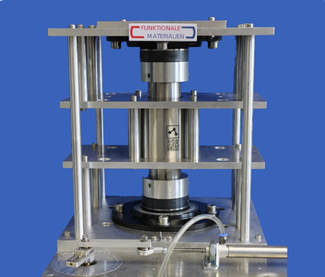
Magnetic Refrigeration with Recycled Permanent Magnets and Free Rare-Earth Magnetocaloric La-Fe-Si
Benke, D., Fries, M., Specht, M., Wortmann, J., Pabst, M., Gottschall, T., Radulov, I., Skokov, K., Bevan, A.I., Prosperi, D., Tudor, C.O., Afiuny, P., Zakotnik, M. and Gutfleisch, O.
Energy Technology doi:10.1002/ente.201901025
In this work we collaborated with Urban Mining Company to show that green magnetic cooling is possible. We designed a magnetic Halbach array which was manufactured by Urban Mining from recycled permanent magnet material. We used it to build a magnetic cooling demonstrator which can be used as a magnetocaloric material testing device. It created up to 30K Temperature span with Gd and up 25K with La-Fe-Si. This proves that recycled magnets are perfectly suitable for magnetic cooling and that green magnetic cooling is possible.
This paper is published under an open access license in Energy Technology and funded by the European Research Council (ERC), DFG (SPP 1599 Ferroic Cooling) and Darmstadt Graduate School of Excellence Energy Science and Engineering (grant no. GSC 1070).
Accelerated crystallization and phase formation in Fe40Ni40B20 by electric current assisted annealing technique
Fernando Maccari, Dmitriy Yu Karpenkov, Elena Semenova, Alexey Yu Karpenkov, Iliya A. Radulov, Konstantin P. Skokov and Oliver Gutfleisch
Journal of Alloys and Compounds 836 (2020) 155338
https://doi.org/10.1016/j.jallcom.2020.155338
We report on the effect of electric current assisted annealing during the crystallization of amorphous Fe-Ni-B ribbons. A designated device allows to measure the sample temperature and electrical resistance. Based on these simultaneous measurements, it is possible to accurately determine the crystallization temperature of (Fe,Ni)3B and for γ-(Fe,Ni) phases. The crystallization onset can be significantly lowered by high electric current densities, reaching a maximum shift of 120°C, and the underlying mechanism is described. Our findings can be extended to the manipulation of phase transitions in different compounds. This work was done in cooperation with colleagues from the National University of Science and Technology Moscow MISIS and Tver State University. This joint work is funded by the DFG-SPP1959 Fields Matter.
Functional Material donates protective equipment against Corona
Since the begining of the crisis the labs are quiet. Most of the group members are working from home office at the moment to prevent the spreading of the corona virus. The urgent need of protective equipment in hospitals inspired our group member Maija Laux to donate the now unused protective equipment like masks, gloves and protective clothing to health facilities. In anticipation with Professor Gutfleisch she initiated the collection also in other labs of the whole university and was able to collect a whole van to help against the shortage.
More detail to this relief operation and to other actions at TUDarmstadt can be found here:
Pressure Dependence of Magnetic Properties in La(Fe,Si) 13 : Multistimulus Responsiveness of Caloric Effects by Modeling and Experiment
D. Yu. Karpenkov, A. Yu. Karpenkov, K. P. Skokov, I. A. Radulov, M. Zheleznyi, T. Faske and O. Gutfleisch
Physical Review Applied 13, 034014 (2020)
DOI: 10.1103/PhysRevApplied.13.034014
In this work, we develop a comprehensive experimental-theoretical approach for the understanding of multistimuli-responsive caloric materials with first-order transitions and for the optimization of their functional properties.
First, we design and build a PPMS based experimental set-up “MaRS”, that can provide a self-consistent set of parameters, such as simultaneously measured magnetization, M ; volume magnetostriction, ω(H)T; and temperature of the sample, T. Second, using as an example the magnetocaloric LaFe11.4 Si1.6 compound with a first-order field-induced transition, and based on the Bean-Rodbell model, we develop a model that allows us to describe analytically the behavior of magnetization under different pressures using our M(T) and ω(T) dependencies measured simultaneously at ambient pressure.
Our model also enables estimation of the temperature dependence of compressibility, κ(T), without carrying out complex and time-consuming XRD measurements of lattice parameters under pressure. Additional parameters, such as the thermal expansion coefficient, α(T), and magnetoelastic interaction or effective magnetovolume coupling constant, CMV, can also be determined within the framework of our approach.
Exchange stiffness of ferromagnets
M. D. Kuz’min, K. P. Skokov, L. V. B. Diop, I. A. Radulov, O. Gutfleisch
Eur. Phys. J. Plus 135, 301 (2020)
https://doi.org/10.1140/epjp/s13360-020-00294-y
Exchange stiffness is an important characteristic of a ferromagnetic material. It is related to the Curie temperature, and determines the width and energy of domain walls. It is a necessary ingredient of any micromagnetic calculation, the applications ranging from the coercivity of bulk materials, through composite (exchange-spring) magnets, to nanoscopic devices such as the racetrack memory.
In this work, spin-wave and exchange stiffness constants of 22 ferromagnetic compounds have been deduced from their spontaneous magnetization, Ms, by using an improved technique. The improvement consists in utilizing the entire Ms(T ) curve, up to the Curie point, rather than just its low-temperature part, with T<<TC. For 17 of the 22 ferromagnets, literature data have been used, while 5 compounds have been studied anew, on single crystals grown for the purpose
Dynamic unidirectional anisotropy in cubic FeGe with antisymmetric spin-spin-coupling
Nicolas Josten, Thomas Feggeler, Ralf Meckenstock, Detlef Spoddig, Marina Spasova, Ke Chai, Iliya Radulov, Zi-An Li, Oliver Gutfleisch, Michael Farle, Benjamin Zingsem
Scientific Reports 10, 2861, (2020)
DOI: 10.1038/s41598-020-59208-8
This work is another excellent example for our successful collaboration with our colleagues from University of Duisburg Essen. We studied bulk polycrystalline B20 FeGe samples by ferromagnetic resonance spectroscopy and as a result we discovered strong unidirectional anisotropy. Such anisotropy is not present in static magnetometry measurements. B20 FeGe exhibits inherent Dzyaloshinskii-Moriya interaction, resulting in a nonreciprocal spin-wave dispersion. Bulk and micron sized samples were produced and characterized. By X-band ferromagnetic resonance spectroscopy at 276 K ± 1 K, near the Curie temperature, a distribution of resonance modes was observed in accordance with the cubic anisotropy of FeGe. This distribution exhibits a unidirectional anisotropy, i.e. shift of the resonance field under field inversion, of KUD = 960 J/m3 ± 10 J/m3, previously unknown in bulk ferromagnets. Additionally, more than 25 small amplitude standing spin wave modes were observed inside a micron sized FeGe wedge, measured at 293 K ± 2 K. These modes also exhibit unidirectional anisotropy. This effect, only dynamically measurable and not detectable in static magnetometry measurements, may open new possibilities for directed spin transport in chiral magnetic systems.
Influence of hydrogenation on the vibrational density of states of magnetocaloric LaFe11.4Si1.6H1.6
A. Terwey, M. E. Gruner, W. Keune, J. Landers, S. Salamon, B. Eggert, K. Ollefs, V. Brabänder, I. Radulov, K. Skokov, T. Faske, M. Y. Hu, J. Zhao, E. E. Alp, C. Giacobbe, O. Gutfleisch and H. Wende
Physical Review B 101, 064415 (2020)
DOI: 10.1103/PhysRevB.101.064415
In this work, performed in close cooperation with University of Duisburg-Essen, Advanced Photon Source (APS), Argonne National Laboratory and European Synchrotron Radiation Facility (ESRF), we studied the impact of magnetoelastic coupling on the magnetocaloric properties of LaFe11.4Si1.6H1.6 in terms of the vibrational (phonon) density of states (VDOS), which we determined with 57Fe nuclear resonantinelastic x-ray scattering (NRIXS) measurements and with density functional theory (DFT) based first-principles calculations in the ferromagnetic (FM) low-temperature and paramagnetic (PM) high-temperature phase. In experiments and calculations, we observe pronounced differences in the shape of the Fe-partial VDOS between nonhydrogenated and hydrogenated samples. This shows that hydrogen not only shifts the temperature of the first-order phase transition, but also affects the elastic response of the Fe subsystem significantly. In turn, the anomalous redshift of the Fe VDOS, observed by going to the low-volume PM phase, survives hydrogenation. Hydrogenation is observed to induce an overall blueshift of the Fe VDOS with respect to the H-free compound; this effect, together with the enhanced Debye temperature observed, is a fingerprint of the hardening of the Fe sublattice by hydrogen incorporation. In addition, the mean Debye velocity of sound of LaFe11.4Si1.6H1.6 was determined from the NRIXS and the DFT data.
Designing rare-earth free permanent magnets in Heusler alloys via interstitial doping
Qiang Gao, Ingo Opahle, Oliver Gutfleisch, Hongbin Zhang
Acta Materialia 186, 1-8 (2020)
DOI: 10.1016/j.actamat.2019.12.049
In this paper, led by the theory group of Jun. Prof Zhang, we report on high-throughput density functional theory calculations. We investigated the effects of light interstitial H, B, C, and N atoms on the magnetic properties of cubic Heusler alloys, with the aim to design new rare-earth free permanent magnets. It is observed that the interstitial atoms induce significant tetragonal distortions, leading to 32 candidates with large ( > 0.4 MJ/m3 ) uniaxial magneto-crystalline anisotropy energies (MAEs) and 10 cases with large in-plane MAEs. Detailed analysis following the perturbation theory and chemical bonding reveals the strong MAE originates from the local crystalline distortions and thus the changes of the chemical bonding around the interstitials. This provides a valuable way to tailor the MAEs to obtain competitive permanent magnets, filling the gap between high performance Sm-Co/Nd-Fe-B and widely used ferrite/AlNiCo materials.
Professor Gutfleisch named for IEEE fellow membership
Oliver Gutfleisch, Professor für Funktionale Materialien am Fachbereich Material- und Geowissenschaften, ist vom Institute of Electrical and Electronic Engineers (IEEE) zum IEEE Fellow ernannt worden. Er erhält die Auszeichnung für seine Beiträge zur Entwicklung von magnetischen Materialien für nachhaltige Energieanwendungen. Das IEEE ist mit über 420.000 Mitgliedern der größte technische Berufsverband der Welt. Es gliedert sich in zahlreiche so genannte Societies, die sich mit speziellen Gebieten der Elektro- und Informationstechnik auseinandersetzen und in ihrer Vielfalt das gesamte Spektrum des Faches abdecken. Der Rang eines IEEE Fellow ist der höchste zu vergebende. Ihn erhält ein Senior Member für außerordentliche Verdienste allein durch das IEEE Board of Directors nach Nominierung durch andere.
http://www.ieeemagnetics.org/index.php?option=com_content&view=article&id=83&Itemid=78
Element-resolved study on the evolution of magnetic response in FexN compounds
Yu-Chun Chen, Dominik Gölden, Imants Dirba, Meng-Jie Huang, Oliver Gutfleisch, Peter Nagel, Michael Merz, Stefan Schuppler, Gisela Schütz, Lambert Alff, Eberhard Goering
Journal of Magnetism and Magnetic Materials 498 (2020) 166219
https://doi.org/10.1016/j.jmmm.2019.166219
In cooperation with Max Planck Institute for Intelligent Systems, Stuttgart and Karlsruhe Institute of Technology, Institute for Solid-State Physics we have performed a systematic XMCD analysis to study the evolution of magnetic moments of overall Fe atoms in α′-FexN thin films. It was found that the spin and orbital moments of overall Fe 3d shell of α′-FexN increase gradually along c-axis with increasing nitrogen fraction. We showed that the magnetocrystalline anisotropy of α′-FexN compounds is associated with the corresponding orbital anisotropy of the Fe 3d shell.
New Collaborative Research Centre “CRC 270 HoMMage” established
The German Research Foundation has approved our application for the Collaborative Research Centre “HoMMage – Hysteresis Design of Magnetic Materials for Efficient Energy Conversion”! The aim of this centre headed by Prof. Oliver Gutfleisch is to develop state-of-the-art functional materials needed to transition to a low emissions future, such as strong permanent magnets for use in wind turbines and electric motors, or magnetic materials for efficient cooling. The joint project together with colleagues from Universität Duisburg Essen, Max-Planck-Institut für Eisenforschung (MPIE) and Ernst Ruska-Centre for Microscopy and Spectroscopy with Electrons at Jülich Research Centre will be funded with 12 million Euros. It will begin its first 4 years on 1st of January 2020.
MagnoTherm Solutions at Falling Walls Conference
The start-up MagnoTherm Solutions from Functional Materials, TU Darmstadt attended this year‘s Falling Walls Conference as a finalist in the venture competition. The start-up, a spin-off of Technische Universität Darmstadt, had been nominated by the university and got the opportunity to present itself together with 27 other finalists in front of a committee of experts in a 5-minute-presentation.
The introduction was given by the Vice President for Knowledge and Technology Transfer of TU Darmstadt Prof. Dr. Mira Mezini. After the introduction, Timur Sirman from MagnoTherm presented, how magnetocaloric cooling can be used as a very efficient an environment-friendly alternative to conventional gas compression and how this is a contribution against climate change.
For the complete presentation, please watch this video.
Calculating the magnetocaloric effect in second-order-type material by micromagnetic simulations: A case study on Co2B
Dominik Ohmer, Min Yi, Maximilian Fries, Oliver Gutfleisch, Bai-Xiang Xu
Scripta Materialia 177 (2020) 218–222
https://doi.org/10.1016/j.scriptamat.2019.10.039
A new calculation scheme for calculating the magnetocaloric effect (MCE) in second-order phase transition materials is proposed. By a combination of micromagnetic simulations and the Arrott-Noakes equation, it is possible to investigate the influence of microstructure and magnetocrystalline anisotropy on the MCE. The calculation scheme is introduced on the example of Co2B. Experimental data of the saturation magnetization are used to perform micromagnetic simulations up to the Curie temperature using the software OOMMF. Using the Arrott-Noakes equation, the results are extrapolated to temperatures above Curie temperature and the isothermal entropy change ΔST is calculated. Comprehensive study of the grain size and magnetocrystalline anisotropy indicates that smaller grains and higher anisotropies can enhance the MCE in Co2B. This work is done within the framework of the CoolInnov project.
MagnoTherm Solutions, Sieger in der Kategorie »Gründung aus der Hochschule«
„Bei der Zahl gewerblicher Gründungen liegt Hessen deutschlandweit auf dem dritten Platz, dank mutiger Unternehmerinnen und Unternehmer, die eine Geschäftsidee haben und bereit sind, ein Risiko einzugehen“, sagte Tarek Al-Wazir, Hessischer Minister für Wirtschaft, Energie, Verkehr und Wohnen. „Wir unterstützen sie mit der Start-up-Initiative, mit Förderungen – oder auch dem Hessischen Gründerpreis. Denn gesellschaftliche Veränderungen wie die digitale Transformation werden ohne kreative Lösungen nicht gelingen. Der Hessische Gründerpreis ist daher Würdigung und Ansporn für alle, die mit ihrer Idee erfolgreich waren und sein wollen.“
Siehe hierzu auch Gefriertruhe ohne gefährliches Gas in der Frankfurter Allgemeinen Zeitung vom 03.11.2019
Making a Cool Choice: The Materials Library of Magnetic Refrigeration
Tino Gottschall, Konstantin P. Skokov, Maximilian Fries, Andreas Taubel, Iliya Radulov, Franziska Scheibel, Dimitri Benke, Stefan Riegg and Oliver Gutfleisch
Advance Energy Materials 9 (2019) 1901322
https://doi.org/10.1002/aenm.201901322
The phase‐down scenario of conventional refrigerants used in gas–vapor compressors and the demand for environmentally friendly and efficient cooling make the search for alternative technologies more important than ever. Magnetic refrigeration utilizing the magnetocaloric effect of magnetic materials could be that alternative. However, there are still several challenges to be overcome before having devices that are competitive with those based on the conventional gas–vapor technology. In this paper a rigorous assessment of the most relevant examples of 14 different magnetocaloric material families is presented and those are compared in terms of their adiabatic temperature and isothermal entropy change under cycling in magnetic‐field changes of 1 and 2 T, criticality aspects, and the amount of heat that they can transfer per cycle. The work is based on magnetic, direct thermometric, and calorimetric measurements made under similar conditions and in the same devices. Such a wide‐ranging study has not been carried out before. This data sets the basis for more advanced modeling and machine learning approaches in the near future.
This article also appears in: Hot Topic: Magnetic Materials.
Ab initio phase stabilities of Ce-based hard magnetic materials and comparison with experimental phase diagrams
H. İ. Sözen, S. Ener, F. Maccari, K. P. Skokov, O. Gutfleisch, F. Körmann, J. Neugebauer and T. Hickel
Physical Review Materials 3 (2019) 084407
DOI: https://doi.org/10.1103/PhysRevMaterials.3.084407
In a cooperation with MPIE Düsseldorf, we investigated the ternary phase diagrams of Ce-Fe-Ti using ab-initio approaches and bulk high throughput screening. The phase stability predictions obtained from the free energy calculations are in good agreement with the experimental reactive crucible melting (RCM) results. The ab-initio based free energy calculations reveal that the presence of the CeFe2 Laves phase suppresses the formation of CeFe11Ti up to 700 K. The result is consistent with RCM, in which CeFe11Ti is only observed above 1000 K, while the CeFe2 and Ce2Fe17 phases are stable at lower temperatures. The joint work is funded by the DFG-ANR Project REMAP.
Public evening lecture at JEMS 2019
In addition to his plenary lecture on “Hysteresis design of magnetic materials for efficient energy conversion” Prof. Gutfleisch gave a public evening lecture at JEMS 2019 on “The element 60 – Neodymium: from critical metals to power-magnets for renewable energy”.
The element 60 – Neodymium – has a dynamic and complex history, its story is continued to be rewritten every day. Neodymium, a member of the group of rare earth elements or lanthanides (the Greek word lanthano meaning I am hidden) is a key element for the great transformation of our energy landscape. It stands exemplarily for a number of strategic and sometimes precious or conflict metals whose sustainable supply or shortage will enable or endanger our path to renewable energy technologies. Most powerful Neodymium magnets are key components of direct drive wind turbines and e-motors, but also in robotics and automatization. In efficient electro mobility, every battery needs a strong magnet. The story of Neodymium is told starting in the year 1787 in Ytterby, Sweden, all the way to the monopolistic supply situation by China today and the integration of these magnets into CO2-efficient energy conversion devices. But how green are the metals in our green technologies and what price do we want to pay for them…
Experimental and computational analysis of binary Fe-Sn ferromagnetic compounds
B.Fayyazi et al.
Acta Materialia 180 (2019) 126
DOI: https://doi.org/10.1016/j.actamat.2019.08.054
A comprehensive study has been performed to investigate structural and magnetic properties of Fe-Sn binary ferromagnetic compounds, Fe3Sn, “Fe5Sn3” and Fe3Sn2 measured on single crystalline samples. By combination of single crystal x-ray diffraction and Transmission Electron Microscope (TEM), we propose a new structural model for “Fe5Sn3” which is different from its previously known Laves structure. The magnetic properties were measured on aligned single crystals and the spontaneous magnetization, Curie temperatures and magnetocrystalline anisotropy energy were determined. These properties were also evaluated in the framework of Density Functional Theory (DFT) and an overall good agreement was observed between the calculated and experimental results. Furthermore, using elaborate techniques such as Magnetic Force Microscopy (MFM) and Kerr microscopy, the domain structure of the compounds was analyzed and for Fe3Sn2 with uniaxial anisotropy by means of different analytical models the magnetocrystalline anisotropy was evaluated.
Professor Gutfleisch verfasst Beitrag zur acatech POSITION
Acatech POSITION (opens in new tab)
acatech analysiert in der gleichnamigen POSITION die „Rahmenbedingungen für die Zukunft der Werkstoffe“. Die Akademie beleuchtet, wie sich Energiepreis oder Emissionshandel, die Verfügbarkeit von Rohstoffen sowie Materialeffizienz und Kreislauffähigkeit auf die Situation der verschiedenen Werkstoffklassen in Deutschland auswirken.
Die Empfehlungen beinhalten einen effizienteren Einsatz von Rohstoffen und eine verstärkte Wiederverwertung.
Professor Gutfleisch contributes an article to acatech POSITION
Acatech POSITION (opens in new tab)
In POSITION of the same title, acatech analyses the frame conditions for “the future of materials”. The academy elucidates, how energy pricing and emission trading as well as material efficiency and recyclability effect the situation of the different material classes used in Germany.
The recommendations include to increase the efficiency of the use of materials and to improve recovery and recycling.
PHD Graduation in FM-Group
We congratulate our colleague Daniel Simon to the successful defense of his doctoral thesis “Development and Assessment of Rare Earth-lean Th1Mn12-Phases or the Use in Permanent Magnets / Entwicklung und Bewertung seltenerdarmer Th1Mn12-Phasen zum Einsatz in Permanentmagneten” on Monday the 8th of July 2019.
We wish Daniel Simon good luck for his future!
Tunable first order transition in La(Fe,Cr,Si)13 compounds: retaining magnetocaloric response despite a magnetic moment reduction
Luis M. Moreno-Ramírez et al.
Acta Materialia 175 (2019) 406-414
DOI: 10.1016/j.actamat.2019.06.022
In this work, performed in close cooperation with Universidad de Sevilla, and Universidad Autónoma de Madrid, we studied the magnetocaloric response of Cr-doped La(Fe,Si)13 compounds combining three different approaches: first-principles calculations, experimental determination of the magnetocaloric response (direct and indirect), as well as a new criterion to determine the order of the phase transition. Despite a reduction in magnetic moment, the magnetocaloric response is retained up to x≈0.3 in LaFe11.6-xCrxSi1.4. Unlike other transition metal dopants, Cr occupy the 8b sites and couples antiferromagnetically to the Fe atoms. The cross-over of first- to second-order transition is observed for a Cr content of x=0.53, which is higher when comparing with other dopants such as Ni or Mn. A direct relation between the first-order character and the hysteresis is observed.
Towards manufacturing of Nd-Fe-B magnets by continuous rotary swaging of cast alloy
Chi et al.
J. Magnetism and Magnetic Materials 490 (2019) 165405
https://doi.org/10.1016/j.jmmm.2019.165405
Nd-Fe-B permanent magnets are manufactured by rotary swaging. Nd-Fe-B alloys were heated and deformed by a rotary swaging process with different stress states, degrees of deformation and feed speeds. Microstructure observation confirmed the drastic grain refinement during swaging which is attributed to grain fracture. At the same time, cohesion of the magnets is maintained as the cracks between the fractured grains were immediately filled with liquid Nd-rich phase. The rotary swaging process enables a continuous manufacturing of Nd-Fe-B permanent magnets directly from castings, with the potential for an alternative processing route to conventional powder metallurgy or hot deformation.
Group seminar in Bronnbach
For three days the functional materials group came together in the quiet monastery of Bronnbach to discuss together about changes in the group structure, strategic investments and future ideas. The ambitious program was embedded in several sports activities and games to provide a good atmosphere for open discussions.
Development of high-coercivity, anisotropic Nd-Fe-B/Fe nanocomposite magnets
Sepehri-Amin et al.
Acta Materialia 175 (2019) 276-285
https://doi.org/10.1016/j.actamat.2019.06.017
Low coercivity and absence of texture have been the main challenges to realize the high (BH)max theoretically postulated for anisotropic nanocomposite magnets. In this work, based on the hydrogenation disproportionation desorption recombination (HDDR) process we have realized in cooperation with NIMS Tsukuba a novel top-down processing route to synthesize anisotropic nanocomposite Nd-Fe-B/α-Fe powders with substantial coercivity. Another remarkable result is that in contrast to the common understanding of exchange-coupled systems, the formation of α-Fe phase with a size up to 200 nm within the matrix of Nd2Fe14B grains can still result in a significant coercivity of 0.85 T.
One event follows the next – Meet & Move
Every year the campus sports festival Meet & Move takes place and offers to try a lot of different sports. As every year an “ultramarathon” is offered, where at least 10 runners share the marathon distance of 42.2 km.
Still motivated and fit from the Merck Firmenlauf, it was easy to build a functional materials team that thrived. After the run the team enjoyed ice cream in the sun and watched the other activities.
ULMAG – Ultimate MAGnetic Characterization
Good news! The Federal Ministry of Education and Research (BMBF) has approved our application for the joint project ULMAG with our colleges from the University of Duisburg-Essen. The aim of the project ULMAG (ULtimate MAGnetic characterization) is to build a unique and versatile experimental set-up to measure under strictly the same experimental conditions element-selective (XMCD), and bulk magnetic properties of materials in combination with x-ray diffraction and other macroscopic properties like magnetostriction, magnetoresistance, magnetoelectric and magnetocaloric effects. This experimental setup is planned to be implemented at beamline ID12 at the European Synchrotron Radiation Facility (ESRF) in Grenoble and will serve as a versatile tool for combined macroscopic and microscopic characterization of (magnetic) materials. In total, the joint project will be funded with 1.4 million euro over a period of 3 years.
Participation at Darmstädter Merck-Firmenlauf 2019 – The Perfect Moment
Also this year 14 members of our group took part at the Darmstädter Firmenlauf on Wednesday the 29th of May. The colleagues prepared together to run the distance of 5 km the weeks before the run. For some it was the first time to experience such an event while the more seasoned runners trained to run faster than the year before. Not only the run itself but also the training bonded our team and increased our fitness.
On the day the weather was perfect and so all of our team members came across the finish line very happily together with more than 4000 participants.
Structural and magnetic properties of Ce1-xSmxFe11-yTi1Vy
Simon et al.
Acta Materialia 172 (2019) 131-138
doi.org/10.1016/j.actamat.2019.04.006
In order to find a promising trade-off permanent magnet material regarding a performance/cost-ratio, we investigated systematically the intrinsic magnetic properties of the Ce1-xSmxFe11-yTi1Vy system, produced nanocrystalline materials and made fully dense magnets by hot compaction. The work was carried out in cooperation with the Robert Bosch GmbH, the KIT, and Forschungsneutronenquelle Heinz Maier-Leibnitz (FRM II).
60 Kelvin in 60 Tesla
Gottschall et al.
PHYSICAL REVIEW B 99, 134429 (2019)
The study of the magnetocaloric effect (MCE) in very high magnetic fields is primarily of fundamental interest. A key quantity describing the MCE is the adiabatic temperature change, which we measured for gadolinium directly in pulsed magnetic fields up to 62 Tesla. Our theory-guided, systematic study aimed specifically at the accurate determination of the MCE and was carried out in cooperation with the Dresden High Magnetic Field Laboratory; Ames Laboratory, U.S. Department of Energy; and Aix-Marseille Université.
New lecture: “Hysteresis in Magnetic Materials”
Starting from this summer semester 2019, the Functional Materials group provides a new lecture for the master studies in material science. The lecture “Hysteresis in Magnetic Materials” will cover the fundamental theory, design principles, and (micro)structure-property-relations of thermal and magnetic hysteresis. Based on these fundamentals, fabrication and applications of magnetic materials are discussed with regard to the role of thermal/magnetic hysteresis.
It will take place every Wednesday of the summer semester at 13:30-15:10, starting from 17.04.2019.
More information can be found on Tucan.
Spin is everywhere!
IEEE Magnetic Society Video „Magnetism and Magnetics Technology in the 21st Century“ can now be viewed on
https://ieeetv.ieee.org/technology/magnetics-technology-21st-century?rf=channels|70&
From our phones to electro-mobility and wind turbines to devices that diagnose medical illness, magnetism is a fundamental tool that enables modern life. This video by the IEEE Magnetics Society, featuring also the Darmstadt Functional Materials Group, provides an overview of the applications of magnetism and why it's such an important field of study and research.
Dynamics of the magnetoelastic phase transition and adiabatic temperature change in Mn1.3Fe0.7P0.5Si0.55
M. Fries, T. Gottschall, F. Scheibel, L. Pfeuffer, K.P. Skokov, I. Skourski, M. Acet, M. Farle, J. Wosnitza and O. Gutfleisch
Journal of Magnetism and Magnetic Materials 477 (2019) 287–291
https://doi.org/10.1016/j.jmmm.2018.12.086
In a joint effort with the University of Duisburg Essen and the High magnetic fields lab in Dresden Rossendorf we studied the dynamics of the magnetostructural phase transition of an Fe2P-type magnetocaloric alloy via measuring the adiabatic temperature change DTad in pulsed magnetic fields. We could show that the first-order transition is indeed field-rate dependent contrary to previous reports and that it can not be completed in fields up to 20T. The findings imply a frequency-dependent increase of hysteresis which could lower the materials efficiency in application.
Magnetic cooling on TV
“We can store food with refrigerators for quite a long time. Good for us, but bad for the environment.” Broadcasted by the German private TV channel SAT.1, Prof. Gutfleisch and his research team from Functional Materials (TU Darmstadt) was featured regarding the potential of magnetic cooling to make refrigeration more efficient and environmentally friendly – from fundamental research to commercialisation. For the video (in German language), click here
https://www.1730live.de/tu-darmstadt-erforscht-neue-kuehltechnik/
Magnetic and magnetocaloric properties of the Co2-xMnxB system by experiment and density functional theory
S. Ener, M. Fries, F. Hammerath, I. Opahle, E. Simon, P. Fritsch, S. Wurmehl, H. Zhang and O. Gutfleisch
Acta Materialia 165 (2019) 270-277
In collaboration with the Institute for Solid State Research, IFW Dresden, and the Theory of Magnetic Materials group at TU Darmstadt, we studied systematically the magnetic properties of Co2-xMnxB system by using advanced characterization techniques and density functional theory (DFT). DFT calculations guide us in the understanding of the origin of the observed anomaly, which is due to a complex magnetic coupling behavior between Mn atoms, which significantly affects the corresponding exchange interactions influencing overall magnetic behavior of the system. Further, advanced magnetic characterization gives us the opportunity to combine and confirm the predictions of DFT by experiments.
https://doi.org/10.1016/j.actamat.2018.11.034
MagnoTherm Solutions wins TU Darmstadt Idea Competition
Out of almost one hundred ideas, MagnoTherm Solutions has been selected as the winner of this year’s TU Darmstadt Idea Competition. After pitching in front of a jury consisting of professors, entrepreneurs and corporate managers, we were able to take the 3,000€ prize money home. We thank everybody from TU Darmstadt, the Functional Materials group and sponsors to make this happen!
Advanced magnetic materials could drive next-generation energy technologies
Prachi Patel and Oliver Gutfleisch
MRS Bulletin 43 (2018) 918-919
https://doi.org/10.1557/mrs.2018.300
Making a serious dent in greenhouse gas emissions will require more efficient ways to convert, store, and use energy, a transition from fossil fuels to renewables, and greener modes of transport. Magnetic materials will play a key role in these endeavors. Magnets are at the heart of electric generators in wind turbines, converting mechanical energy into electricity. Magnetic materials could also be the answer for next-generation cooling technologies.
PHD Graduation in FM-Group
We congratulate our colleague Tim Oliver Helbig to the successful defense of his doctoral thesis “Demagnetizing and hardening mechanisms in Nd-Fe-B and Sr-hexaferrite permanent magnets” on Friday the 26th of October 2018. After the exam the group celebrated together the after-defense ceremony.
We thank him for the years we could work together and wish him good luck for his future career. Let´s stay in touch!
Spin-off project MagnoTherm Solutions
Funded by the German Ministry of Economic Affairs and Energy, MagnoTherm Solutions aims to commercialize magnetic cooling and heating engines. With Prof. Gutfleisch as advisor and mentor, Dr. Max Fries and his team from the group of Functional Materials seek to bring academic research and developments from TU Darmstadt to market. We are happy to announce that the project officially starts on the first of October 2018.
Without the need of harmful or climate-damaging refrigerant liquids and with a significant higher energy efficiency, magnetic cooling has the potential to replace conventional gas compressors in cooling and heating applications.
To get in touch with the team please write to: info@magnotherm-solutions.com
DGM Prize 2018
Within the „Materials Science and Engineering“ (MSE) Conference in Darmstadt from 26. – 28. September 2018 the German Materials Society (DGM) Prof. Oliver Gutfleisch was awarded the DGM Prize 2018. The Prize recognises exceptional achievements of excellent scientists at the centre of their career. Gutfleisch is awarded for his outstanding works on permanent magnetism and magnetic refrigeration. At the MSE-conference he will give a plenary talk on „Rare earth high performance magnets for energy applications: Demand, sustainability and the reality of alternatives“.
Kolloqium
Optimization of nanocomposite materials for permanent magnets by means of micromagnetic modelling
D.V. Berkov, S.G. Erokhin, N.L. Gorn
General Numerics Research Lab e.V., Jena, Germany
In this talk we present a new methodology for micromagnetic simulations of magnetic nano-composites. Our methodology combines the main advantages of the finite-difference method (efficient evaluation of the magnetodipolar interaction via the fast Fourier transfo¬mation) and the finite-element approach (flexibility by the discretization of arbitrary shapes). We discuss the results obtain with this method for three very different systems:
(i) Iron-based nanocomposite from the Nanoperm (FeZrBCu) family of alloys, where we compute the magnetization curve and compare our results with the corresponding small-angle neutron scattering (SANS) cross-section data. A remarkable agreement with nontrivial “clover-leaf” SANS cross-sections observed experimentally is demonstrated.
(ii) Nanostructured Sr-ferrite-based composites for permanent magnets, where we study the dependence of most impor¬tant material characteristics (coercivity, remanence, energy product) on the structural and magnetic parameters of a composite. In particular, we demonstrate that – in contrast to the common belief – in systems containing hard grains embedded in the iron matrix, the energy product is a non-monotonic function of the intergrain exchange. The influence of the magnetodipolar interaction between hard crystallites and the soft phase and the role of the grain shape will also be discussed.
(iii) Nanocrystalline Nd–Fe–B (a potential material for future permanent-magnet applications), for which we compare three different models of this material class: (i) description in terms of Stoner–Wohlfarth particles with and without the magnetodipolar interaction; (ii) core-shell representation of the nanograins; (iii) the latter model including a contribution of superpara¬magnetic clusters. We show that only the last – most sophisticated – model is able to provide an excellent agreement with the measured hysteresis loop.
The presented methodology is generally applicable to multiphase magnetic nanocomposites and it highligths the complex interrelationship between the microstructure, magnetic inter-actions, and the macroscopic magnetic properties.
Keep Cool
Researchers develop magnetic cooling cycle
As a result of climate change, population growth, and rising expectations regarding quality of life, energy requirements for cooling processes are growing much faster worldwide than for heating. Another problem that besets today's refrigeration systems is that most coolants cause environmental and health damage. A novel technology could provide a solution: refrigeration using magnetic materials in magnetic fields.
A multicaloric cooling cycle that exploits thermal hysteresis
Tino Gottschall, Adrià Gràcia-Condal, Maximilian Fries, Andreas Taubel, Lukas Pfeuffer, Lluís Mañosa, Antoni Planes, Konstantin P. Skokov & Oliver Gutfleisch
Thermag 2018
International conference on caloric cooling
Thermag VIII took place in Darmstadt and was organized by the functional materials group.
267 experts from 24 different countries visited the conference to exchange their recent research results and discuss the future of the field. The topics covered in the conference were extended for the first time from magnetocaloric refrigeration at room temperature to cover all the different caloric effects that are able to provide cooling at different temperatures.
The next Thermag conference will be held 2020 in College Park (Maryland), USA.
A quantitative criterion for determining the order of magnetic phase transitions using the magnetocaloric effect
J.Y. Law, V. Franco, L. Moreno-Ramírez, A. Conde, D. Karpenkov, I. Radulov, K. Skokov, O. Gutfleisch
In Nature Communications (2018) 9:2680
https://www.nature.com/articles/s41467-018-05111-w
In cooperation with the University of Sevilla we proposed a quantitative criterion for determining the order of magnetic phase transitions using the magnetocaloric effect. The ideal magnetocaloric material would lay at the borderline of a first-order and a second-order phase transition. Hence, it is crucial to unambiguously determine the order of phase transitions for both applied magnetocaloric research as well as the characterization of other phase change materials. We describe a quantitative fingerprint of first-order thermomagnetic phase transitions and demonstrate the validity of the model for different magnetic materials, composites and inhomogeneous materials.
SAVE THE DATE
Together with EIT Raw Materials and under the umbrella of the European Battery Alliance (EBA), we organise a 2-day workshop on Sustainable Materials for Future Mobility: E-drives. Magnets. Batteries, which will take place 23-24 October 2018 in Darmstadt, Germany. The objectives are the creation of cross-value chain alliances, define and implement demonstration projects, and define an agenda towards sustainable battery and e-drives technologies. Attendance is free of charge. For more information see the event website: https://www.lyyti.fi/p/Sustainable_Materials_for_Future_Mobility_Edrives_Magnets_Batteries_4940
Fundamental aspects of cryogenic gas liquefaction by magnetic cooling
Within the German-Russian Program “Helmholtz-RSF Joint Research Groups” on “Energy Storage and Grid Integration” we will start a three-year project on “Fundamental aspects of cryogenic gas liquefaction by magnetic cooling”. The project is led by the Helmholtz-Zentrum Dresden-Rossendorf (HZDR) and the Russian partner is the University of Chelyabinsk. The aim is to develop alternatives to conventional hydrogen liquefaction using solid state magnetic cooling at low temperatures and with this enable new options in energy storage and electro mobility.
Group Seminar in Manigod, France
As in the previous years also this year an internal group seminar took place. From 25.06. to 29.06. the group went to Manigod in France and stayed in Chalet Giersch. The beautiful surrounding of the Alps was the background for our discussions and presentations. Many new ideas came to life in the workshop during the seminar. The weather was friendly and so the pool could be used to refresh the heads afterwards.
The accommodation offered the possibility to cook together in the group, a task that had to be fulfilled in teams. By this task the solidarity of the group was fostered and new experiences have been made. All kitchen teams provided really delicious food and also a barbecue was organized.
The program was complemented by a nice hiking trip through the mountains.
On Friday all members came back healthily but tired from the long bus trip and the intensive work.
Hysteresis design of novel magnetocaloric materials ‐ from basic mechanisms to applications
F. Scheibel et al., in Energy Technology, Available online 14 June 2018
https://doi.org/10.1002/ente.201800264
In this review, we discuss first-order magnetostructural phase transitions in the most relevant magnetocaloric compounds. We present studies under static and dynamic conditions at micro- and mesoscopic scales and elucidate the electronic, magnetic and lattice entropy contributions. We describe transitional hysteresis, a loss‐source limiting reversibility of the adiabatic temperature change, and explain strategies for maximizing efficiency. The review is based on a long term collaboration with our partners from University Duisburg-Essen within the DFG Program Ferroic Cooling.

Manipulation of matter by electric and magnetic fields: Toward novel synthesis and processing routes of inorganic materials
O. Guillon, C. Elsässer, O. Gutfleisch, J. Janek, S. Korte-Kerzel, D. Raabe, C.A. Volkert
in Materials Today published June 2018
Out of the DFG SPP 1959 we wrote a review on the use of external electric and magnetic fields for the synthesis and processing of inorganic materials such as metals and ceramics. Electromagnetic energy can be utilized in different ways to improve or accelerate phase formation and stabilization, chemical ordering, densification and coarsening of particle-based materials (pore elimination and grain growth), and mechanical deformation (plasticity and creep). In these new synthesis and processing routes, the resulting microstructures and macroscopic material behavior are determined by the interaction of the applied fields with defects such as single or clustered point defects, dislocation networks, and interfaces. Multiscale experimental investigations and modeling are necessary to unveil the mechanisms underlying this field-assisted manipulation of matter.
https://www.sciencedirect.com/science/article/pii/S1369702117306909
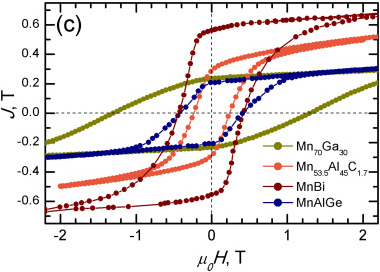
Heavy rare earth free, free rare earth and rare earth free magnets – vision and reality
K.P. Skokov and O. Gutfleisch, in Scripta Materialia View Point, Published September 2018
It is commonly understood that among the intermetallic phases used for permanent magnets, practically none can fully realize its potential based on the intrinsic magnetic properties. We discuss different reasons leading to this limitation, known as the Brown paradox, and propose some possible ways of overcoming it. We compare the intrinsic magnetic properties of (Nd1−xCex)2(Fe1−yCoy)14B single crystals with the extrinsic characteristics of sintered and hot compacted magnets made from the very same alloys. In addition, looking at RE-free materials, our results obtained on Mn- and Co-based RE-free single crystals are compared with the hard magnetic properties of Mn-based permanent magnets.
https://www.sciencedirect.com/science/article/pii/S1359646218300599
Group-event Merck-Firmen-Lauf 2018
On Wednesday 16.05.18 our FM running team started together with 5000 other runners at the Merck-Firmenlauf. This was the 7th time the event took place and the 3rd time we were participating. After weeks of preparation behind them, all runners crossed the finishing line much faster than anticipated. The Functional Materials mixed team got position 23 out of 433 teams in total, a position we are very proud of. But more importantly, we gained a better fitness and grew together as a team. After the running event the day was celebrated in the Bayerischer Biergarten in the Bürgerpark Darmstadt. (CM)
New DIN SPEC 91373 Magnetocalorics – Terminology now published
The document is ready to download: https://www.beuth.de/de/technische-regel/din-spec-91373/288638546
Functional Materials at TU Darmstadt is leading a DIN Project with an international working group consisting of developers and researchers from both academia and industry. A new DIN SPEC providing a unified terminology for magnetocalorics has been developed and published. It is aimed at researchers, manufacturers and users. Magnetocalorics has seen a huge expansion in scientific publications and conferences over the last decade. Emerging from these developments a magnetic cooling industry value chain is now taking shape.
PhD-graduation in the FM group
We are happy to congratulate our new colleague Franziska Scheibel to her defense. She did her PhD thesis Influence of hysteresis at magnetostructural transitions on the magnetocaloric properties of Heuslers, Antiperovskites, and Pnictides at the University Duisburg-Essen.
Magnetocaloric materials for refrigeration near room temperature
Anja Waske, Markus E. Gruner, Tino Gottschall, Oliver Gutfleisch
in MRS Bulletin Caloric Effects in Ferroic Materials Vol. 43 (4) – April 2018, pp. 269-273
This article overviews the current status of magnetocaloric materials for room-temperature refrigeration. We discuss the underlying mechanism of the magnetocaloric effect and illustrate differences between first- and second-order type materials starting with gadolinium as a reference system. Beyond the key functional properties of magnetocaloric materials, the adiabatic temperature, and entropy change, we briefly address the criticality of the most promising materials in terms of their supply risk. Looking at practical applications, suitable geometries and processing routes for magnetocaloric heat exchangers for device implementation are introduced.
Towards an Alloy Recycling of Nd–Fe–B Permanent Magnets in a Circular Economy
O. Diehl, M. Schönfeldt, E. Brouwer, A. Dirks, K. Rachut, J. Gassmann, K. Güth, A. Buckow, R. Gauß, R. Stauber, O. Gutfleisch
Journal of Sustainable Metallurgy (2018)
https://doi.org/10.1007/s40831-018-0171-7
Rare earth permanent magnets are an integral part of many electrical and electronic devices as well as numerous other applications, including emerging technologies like wind power, electric vehicles, fully automized industrial machines, and robots. Due to their outstanding properties, magnets based on Nd–Fe–B alloys are often not substitutable by employing less critical material systems. Our joint paper with Fraunhofer IWKS presents material-to-material recycling approaches maintaining the magnet alloys and using them directly for a new magnet production loop. The recycled magnets compete well with those made from primary materials and have a much reduced environmental footprint; an important step regarding the shift towards a Green Economy.
Microstructural origin of hysteresis in Ni-Mn-In based magnetocaloric compounds
H.Sepehri-Amin, A.Taubel, T.Ohkuboa, K.P.Skokov, O.Gutfleisch, K.Hono
Acta Materialia 147, 342-349 (2018)
https://doi.org/10.1016/j.actamat.2018.01.044
In cooperation with NIMS Tsukuba, the microstructural origins of thermal hysteresis in Heusler alloys were analyzed to show that nano-scale control of the microstructure is the key factor to minimize the thermal hysteresis of the Ni-Mn-In based magnetocaloric compounds. Therefore, two model specimen of Ni-Mn-In and Ni-Fe-Mn-In showing a small and large thermal hysteresis respectively were investigated. It can be shown by TEM imaging and 3D atom probe techniques that a homogeneous and continuous phase transition occurs for the sample with small hysteresis showing an increased Ni content within the twin boundaries, which serve as nucleation centers for the transition. For the large hysteresis sample, nano-precipitates of Fe as well as differently ordered structures of the Austenite lead to a non-uniform and discontinuous phase transition throughout the sample, resulting in an increased thermal hysteresis.
PhD-graduation in the FM group
We are happy to congratulate our dear colleague Fabian Rhein to his defense. He worked on his thesis Nanoskalige Magnete und Magnetkomposite auf Ferritbasis mainly at the company Siemens. The defense was followed up by a visit of a local brewery and a little after-defense ceremony by his colleagues.
Origin of field-induced discontinuous phase transitions in Nd2Fe17
L. V. B. Diop, M. D. Kuz’min, K. P. Skokov, Y. Skourski, and O. Gutfleisch
Phys. Rev. B 97, 054406 (2018)
https://doi.org/10.1103/PhysRevB.97.054406
Magnetic properties of a trigonal ferromagnet Nd2Fe17 have been studied on single crystals in steady (14 T) and pulsed (32 T) magnetic fields. The easy-magnetization direction lies close to the [120] axis, deviating from the basal plane by 2.9° (at 5 K). Of particular interest is the low-temperature magnetization process along the high-symmetry axis [001], which is the hard direction. This process is discontinuous and involves two first-order phase transitions (FOMPs). One of them (at 20 T) is a symmetry FOMP similar to that observed in Sm2Fe17. The second transition (at 10.4 T) is without precedent: as the magnetization turns abruptly towards the applied field, it also changes its azimuthal orientation (the angle φ) by 60°. Both transitions can be reasonably accounted for by the presence of a significant sixth-order trigonal anisotropy term.
Consolidation of cobalt nanorods: A new route for rare-earth free nanostructured permanent magnets
Semih Ener, Evangelia Anagnostopoulou, Imants Dirba, Lise-Marie Lacroix, Frederic Ott, Thomas Blon, Jean-Yves Piquemal, Konstantin P. Skokov, Oliver Gutfleisch and Guillaume Viau
Acta Materialia 145 (2018) 290-297
For the first time the bottom-up approach is convincingly reported to produce bulk, anisotropic magnets without the addition of any matrix. The obtained nanostructured materials exhibit coercivity much higher than the AlNiCo magnets and can fill the performance “gap” between hexaferrites and rare-earth based magnets. In this work, we propose alternative consolidation and densification routes for cobalt nano-rods to yield performant permanent magnets. Cobalt NRs with various diameters were produced and compacted under different conditions. The magnetic properties and the performance of the consolidated magnets are discussed in relationship with their microstructure analyzed by neutron scattering and X-ray diffraction.
Bulk combinatorial analysis for searching new rare-earth free permanent magnets: Reactive crucible melting applied to the Fe-Sn binary system
Bahar Fayyazi, Konstantin P. Skokov, Tom Faske, Dmitriy Yu Karpenkov, Wolfgang Donner and Oliver Gutfleisch
Acta Materialia 141 (2017) 434-443
https://doi.org/10.1016/j.actamat.2017.09.036
The reactive crucible melting (RCM) method is known to be an efficient and low-cost bulk combinatorial synthesis technique to search for new phases. In this work, reliability of the RCM method was evaluated by investigating the Fe-Sn binary system. The phase compositions forming in the RCM were compared with phases appearing in conventionally melted samples and the phases represented in the reported Fe-Sn phase diagram. For high-throughput characterization, energy dispersive x-ray spectroscopy and magneto-optical Kerr microscopy were used. It was found that in certain cases, the phase relations expected in equilibrium conditions were not completely reproduced in RCM samples. The problem of ‘missing phases’ is discussed. In addition, in Fe3Sn2 phase with uniaxial anisotropy, we demonstrate the erroneous of the quantitative measurement of K1 using the domain structure by comparing with the measured anisotropy on a single phase sample using conventional magnetometry. Finally, a new structural model is introduced for the Fe5Sn3 compound.
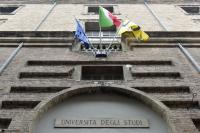
Visiting Professor at the University of Parma
Oliver Gutfleisch has started a Visiting Professorship at the University of Parma for the period of 2017/2020. He is formally enrolled at the Material Science PhD College of tutors at the University of Parma, and will be involved in the teaching activities as well as the joint supervision of a PhD candidate in an effort to expand and strengthen the international profile of the university. The University of Parma is one of the oldest universities in the world and dates back to the year 962.
Influence of magnetic field, chemical pressure and hydrostatic pressure on the structural and magnetocaloric properties of the Mn–Ni–Ge system
Andreas Taubel, Tino Gottschall, Maximilian Fries, Tom Faske, Konstantin P. Skokov, Oliver Gutfleisch
J. Phys. D: Appl. Phys. 50 464005 (2017), https://doi.org/10.1088/1361-6463/aa8e89
For magnetocaloric cooling applications, the MM’X alloys with a sharp phase transition from high temperature paramagnetic hexagonal to low temperature ferromagnetic orthorhombic phase recently came into focus of research. Our study on the isostructural alloying of the Mn-Ni-Ge system by introducing Fe for Mn and Si for Ge shows the benefit of this material family for precisely tunable structural and magnetic properties. The high dependence on sample size and shape connected to the enormous volume change during phase transition of about 3% is demonstrated by high isothermal entropy changes of small pieces and directly measured temperature changes for polymer bonded powder. This large volume difference between the two occurring phases offers a large potential for pressure-assisted magnetocaloric cycles and barocaloric applications.
Save the Date for Thermag VIII
International Conference on caloric cooling
You are hereby cordially invited to attend Thermag VIII – International Conference on Caloric Cooling, which will be held in Darmstadt, Germany on 16.-20. September 2018. The conference provides a platform for scientists and engineers from all over the world working in the field of caloric materials and devices to get together and discuss their research and ideas.
More information on thermag2018.de.

REGINA – Globale Industrien Seltener Erden und neue Anwendungen
Ein Konsortium aus acht deutschen wissenschaftlichen Institutionen und Unternehmen inklusive der TU Darmstadt wird unter der Leitung der Fraunhofer-Projektgruppe IWKS gemeinsam mit brasilianischen Partnern aus Wissenschaft und Wirtschaft daran arbeiten, eine Prozesskette zur Herstellung und Vermarktung von Hochleistungspermanentmagneten aus brasilianischen Ressourcen aufzubauen. Gesamtziel ist es, eine Grundlage für die industrielle Umsetzung der Wertschöpfungskette, ausgehend von gemischten Seltenerdoxiden aus brasilianischen Minen, über die Seltenerdaufbereitung, bis hin zum fertigen Nd-Fe-B-Magneten zu schaffen. Der Aufbau einer brasilianischen Nd-Fe-B-Magnetproduktion soll Brasilien als strategischen und verlässlichen Lieferanten von Seltenen Erden in Deutschland etablieren. Diese Magnete sollen den auf chinesischen seltenen Erden basierenden Magneten leistungsmäßig vergleichbar, jedoch im Hinblick auf Umwelt- und Sozialverträglichkeit überlegen sein und das Prädikat „grüner Magnet“ für den Einsatz in grünen Technologien verdienen.
Die TU Darmstadt unter der Leitung von Prof. Gutfleisch (Fachgebiet Funktionale Materialien) wird sich innerhalb dieses Konsortiums speziell mit der Optimierung der Legierungen sowie der Synthese und hochauflösenden Charakterisierung der Magnete beschäftigten und diese Entwicklung vorantreiben. Das Forschungsvorhaben ist auf drei Jahre angelegt und wird vom Bundesministerium für Bildung und Forschung (BMBF) mit ca. 2,9 Mio. im Rahmen des Förderschwerpunktes »CLIENT II – Internationale Partnerschaften für nachhaltige Innovationen« im Rahmenprogramm »FONA – Forschung für nachhaltige Entwicklung« gefördert. Davon werden 0,57 Mio. € für die Optimierung der Legierungen und Magnete der Arbeitsgruppe Gutfleisch bereitgestellt. Projektstart war im August 2017.
Mehr Informationen im offiziellen Pressebericht (opens in new tab) .
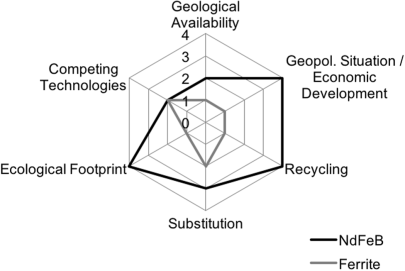
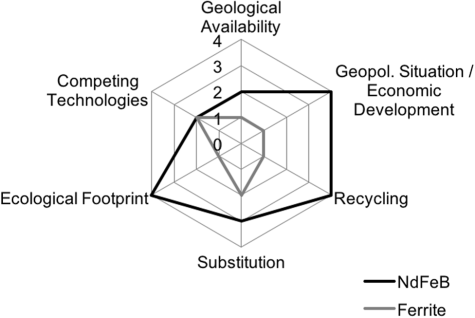
The 2017 Magnetism Roadmap
TOPICAL REVIEW: The 2017 Magnetism Roadmap
D. Sander et al.
Journal of Physics D: Applied Physics, Volume 50, Number 36 (2017) 363001
This Topical Review gives an accurate snapshot of the world of magnetism in 2017. It focuses e.g. on the significantly growing interest in magnetism and magnetic materials in relation to energy applications. The three core pillars of magnetism, namely magnetic materials, magnetic phenomena and associated characterization techniques, as well as applications of magnetism are addressed by an international group of 14 experts. The 2017 Magnetism Roadmap article provides a frame that will enable the reader to judge where each subject and magnetism research field stands overall today and which directions it might take in the foreseeable future.
http://iopscience.iop.org/article/10.1088/1361-6463/aa81a1/meta
PhD-graduation in the group of Functional Materials
We congratulate our colleague Maximilian Fries to his defense. He successfully defended his work entitled Phase transitions of borides and phosphides for application in magnetic energy conversion.
The defense was followed in the evening by a nice barbecue with colleagues and friends of the department and an after-defense ceremony by his colleagues. We thank Max for his effort in the group of Functional Materials which often went far beyond his thesis and are happy that he will continue his work within the group.
Darmstadt Symposium
The great transition – The importance of critical metals for green energy technologies
On July 13, 2017, we hosted a one-day symposium at the Orangerie in Darmstadt focusing on how the supply situation of strategic metals can directly impact on the development and cost of advanced materials which form the basis for green energy technologies. The efficient utilisation or substitution of these critical elements with more sustainable and earth abundant elements is the big challenge for the Great Transition from a fossil fuel based society to an economy built on renewable energies. Well-known experts from academia and industry gave Key-note lectures addressing the substitutionability of critical metals and its possible side effects in terms of entering new dependencies. With more than 150 participants the symposium found a very positive resonance and we will make the Darmstadt Symposium a regular event in the future.
Ministerbesuch in Hanau
Hessens Wirtschafts- und Energieminister Tarek Al-Wazir informierte sich vor Ort über aktuelle und geplante Tätigkeiten der Fraunhofer-Projektgruppe IWKS
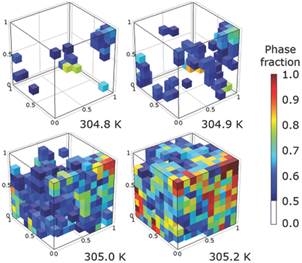
Size matters!
Tino Gottschall, Dimitri Benke, Maximilian Fries, Andreas Taubel, Iliya A. Radulov, Konstantin P. Skokov and Oliver Gutfleisch
Adv. Funct. Mater. 2017, 1606735. https://doi.org/10.1002/adfm.201606735
Solid-state magnetic refrigeration is a high-potential, resource-efficient cooling technology. However, many challenges involving materials science and engineering need to be overcome to achieve an industry-ready technology. Caloric materials with a first-order transition—associated with a large volume expansion or contraction—appear to be the most promising because of their large adiabatic temperature and isothermal entropy changes. In this study, using experiment and simulation, it is demonstrated with the most promising magnetocaloric candidate materials, La–Fe–Si, Mn–Fe–P–Si, and Ni–Mn–In–Co, that the characteristics of the first-order transition are fundamentally determined by the evolution of mechanical stresses. This phenomenon is referred to as the stress-coupling mechanism. Furthermore, its applicability goes beyond magnetocaloric materials, since it describes the first-order transitions in multicaloric materials as well.
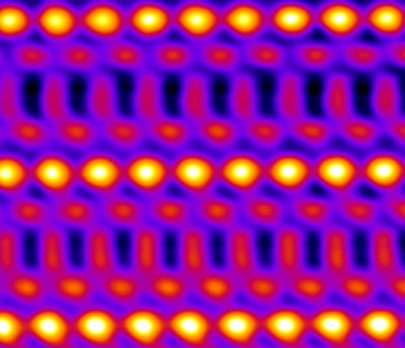
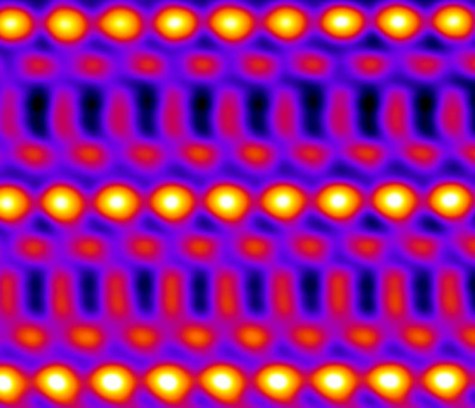
Atomic structure and domain wall pinning in samarium-cobalt-based permanent magnets
M. Duerrschnabel, M. Yi, K. Uestuener, M. Liesegang, M. Katter, H.-J. Kleebe, B. Xu, O. Gutfleisch & L. Molina-Luna
Nature Communications 8:54 (2017)
A higher magnetization by increased iron contents can yield larger energy products in rare-earth Sm2Co17-type pinning-controlled permanent magnets, which are of importance for high-temperature industrial applications. We present model magnets with an increased iron content based on a unique nanostructure and -chemical modification route using Fe, Cu, and Zr as dopants. The iron content controls the formation of a diamond-shaped cellular structure that dominates the density and strength of the domain wall pinning sites. Using ultra-high-resolution experimental and theoretical methods, we revealed the atomic structure of the single phases present and established a direct correlation to the macroscopic magnetic properties.
doi:10.1038/s41467-017-00059-9
https://www.nature.com/articles/s41467-017-00059-9
https://www.tu-darmstadt.de/vorbeischauen/aktuell/einzelansicht_181952.de.jsp
A ‘green’ magnetic cooling device built using ‘upcycled’ NdFeB magnets
Magnetocaloric devices hold the potential to satisfy the rising demand for cooling in the future. One remaining challenge is to reduce the high ecological footprint of the permanent magnets driving the magnetic cooling cycle. Existing devices use neodymium-iron-boron (NdFeB)-type permanent magnets, which account for more than 50% of the ecological footprint of the appliance. To overcome this hurdle, TU Darmstadt and Urban Mining Company have built the first working magnetocaloric device that uses recycled NdFeB as a magnetic field source. Coupling this with optimization of the magnets and their geometry, it is possible to further reduce the ecological footprint. Together, these two approaches help to position magnetic cooling as a realistic and sustainable cooling technology.
For more information see our White Paper (opens in new tab) on this topic.


Neubau für die Fraunhofer-Projektgruppe IWKS
Im neu ausgewiesenen Fraunhofer-Science-Park in Hanau wurde mit einem Spatenstich am 14.6. 2017 der Neubau für die Fraunhofer-Projektgruppe für Wertstoffkreisläufe und Ressourcenstrategie IWKS eingeleitet. Die Projektgruppe wurde 2011 unter dem Dach des Fraunhofer Instituts für Silicatforschung ISC ins Leben gerufen. Vor dem Hintergrund knapper und teurer werdender Rohstoffe werden hier die Voraussetzungen erforscht, wie die Rohstoffversorgung der Industrie langfristig gesichert werden kann. Dafür werden zusammen mit Industriepartnern Trenn-, Sortier-, Aufbereitungs- und Substitutionsmöglichkeiten erforscht und Strategien zum nachhaltigen Umgang mit kostbaren Ressourcen entwickelt. Prof. Dr. Liselotte Schebek und Prof. Dr. Oliver Gutfleisch von der TU Darmstadt sind als wissenschaftliche Leiter für zwei Bereiche an der Projektgruppe beteiligt.


TU Darmstadt and DIN work on standardization of Magnetocalorics
In order to increase the technological readiness of magnetocaloric cooling and to motivate more researchers to work on magnetocaloric cooling, the German institute for standardization DIN decided to create standards in this field. Funktionale Materialien was assigned to work on this topic in the DIN Connect Project Calorinorm which will take two years (2017-2018).
In this project two DIN SPEC will be established which will standardize the terminology of magnetic refrigeration and the measurement procedures of magnetocaloric materials.
Tino Gottschall wins Best Dissertation Award
The association “Vereinigung von Freunden der technischen Universität Darmstadt” awards every department with an award for the best disseration. This year Tino Gottschall won the award for the Materials Science Department. The award is endowed with 2500€.


Cool Research
The European Research Council (ERC) honors Professor Oliver Gutfleisch with an “ERC Advanced Grant” and promotes him with 2.5 million euros over a period of five years. This recognizes outstanding research at the TU Darmstadt for the substitution of critical raw materials and materials for energy technologies.
Microstructural and magnetic properties of Mn-Fe-P-Si (Fe2P-type) magnetocaloric compounds
M. Fries, L. Pfeuffer, E. Bruder, T Gottschall, S. Ener, L.V.B. Diop, T. Gröb, K. P. Skokov, O Gutfleisch
Acta Materialia 132 (2017) 222-229
Mn-Fe-P-Si-based magnetocaloric compounds were prepared using a powder metallurgical process and their microstructural and thermomagnetic properties were analyzed. XRD, SEM, EDX and EBSD analysis reveal a phosphorous depleted cubic secondary phase in many samples with distinct microstructural properties giving an insight into the phase formation process. A porous morphology was found, hindering the direct application of the materials a magnetocaloric heat exchanger in bulk-like structures (see Figure). Thermomagnetic measurements reveal a difference in transition temperature Tt in comparison to literature values which is attributed to a processing induced deviation from the nominal composition. The effect of secondary phases is discussed and the importance of the metal/non-metal (M/NM)-ratio is shown. The article presents a road map for the preparation of Mn-Fe-Si-P-based alloys with highest quality.
REE Recovery from End-of-Life NdFeB Permanent Magnet Scrap: A Critical Review
Yongxiang Yang, Allan Walton, Richard Sheridan, Konrad Guth, Roland Gauß, OliverGutfleisch, Matthias Buchert, Britt-Marie Steenari, Tom Van Gerven, Peter Tom Jones, Koen Binnemans
Journal of Sustainable Metallurgy vol. 3, issue 1 (2017) 122-149
Recycling of REEs contained in magnets from End-of-Life (EOL) products such as consumer electronics, electric and hybrid vehicles (EVs, HEVs) and modern wind turbines will play an important and complementary role in the total supply of REEs in the future. Within the EU MC-ITN EREAN: European Rare Earth Magnet Recycling Network we reviewed the technologies to recover the REEs from these magnets, including physical processing and separation, direct alloy production, and metallurgical extraction and recovery.
Welt der Materialien
On Saturday, 18.02.2017, the FM group participated in the „Welt der Materialien“– Open Day of the Material Science department. Many interested people including younger and older pupils, i.e. our prospective students, as well as families enjoyed the presentations of our research topics in a playful way. Soft and super strong magnets, levitating graphite, a Gauss canon, insights into electromotors, a solar-powered frictionless Mendocino motor and much more could be experienced and was explained by our committed staff. As a highlight, our self-constructed magnetocaloric demonstrator has been shown to visualize the concept of the magnetic cooling technology. In summary, it was an interesting day with lectures, nice cake and a lot of science at your fingertips for everyone.
Production and properties of metal-bonded La(Fe,Mn,Si)13Hx composite material
I.A. Radulov, D.Yu. Karpenkov, K.P. Skokov, A.Yu. Karpenkov, T. Braun, V. Brabänder, T. Gottschall, M. Pabst, B. Stoll, O. Gutfleisch
Acta Materialia 127 (2017) 389
We developed a new method for the production of La(Fe,Mn,Si)13Hx-based magnetocaloric composites using a metal binder with a low melting temperature. Dehydrogenation of the powder during the net-shaping process can be prevented and good mechanical integrity, high thermal conductivity and corrosion resistance of the heat exchanger is ensured. Our patented method can be applied for production of metal-bonded composite of any other mechanically unstable magnetocaloric material, e.g. Fe2P-based compounds or Heusler alloys.
High-performance solid-state cooling materials: Balancing magnetocaloric and non-magnetic properties in dual phase La-Fe-Si
Y. Shao, J. Liu, M. Zhang, A. Yan, K.P. Skokov, D. Yu Karpenkov, O. Gutfleisch
Acta Materialia 125 (2017) 506-512
In cooperation with Ningbo Institute of Material Technology and Engineering, Chinese Academy of Sciences, we demonstrate how the intrinsic brittleness and relatively low thermal conductivity in magnetocaloric La-Fe-Si-H alloys can be overcome by adding extra α-Fe as a reinforcing phase enabling the fabrication of La-Fe-Si-H blocks and plates with good cyclic stability, large and reproducible adiabatic temperature change and improved thermal conductivity.
Correlation of microchemistry of cell boundary phase and interface structure to the coercivity of Sm(CoFeCuZr)7.19 sintered magnets
H. Sepehri-Amin, J. Thielsch, J. Fischbacher, T. Ohkubo, T. Schrefl, O. Gutfleisch, K. Hono
Acta Materialia 126 (2017) 1-10
In cooperation with NIMS Tsukuba, Danube University Krems, and IFW Dresden we revisited the microstructure of Sm2Co17-type sintered magnets. Detailed magnetic measurements, MFM, high resolution STEM-HAADF and 3D atom probe in combination with micromagnetic simulations revealed how the pinning strength of the cell boundary phase correlates with local anisotropy and macroscopic coercivity upon different heat treatments.
Thermag 2018 in Darmstadt
International Conference on Caloric Cooling
This conference organized by the Department of Functional Materials (chair Prof. Oliver Gutfleisch) at TU Darmstadt together with the International Institute of Refrigeration (IIR) is the 8th event in the Thermag series. The scope of the conference will be extended beyond magnetocalorics and will now include elastocalorics, barocalorics and electrocalorics. In addition to cooling at room temperature, cooling at low temperatures and thermomagnetic power generation are to be considered. The conference will take place from 16.09.2018 to 20.09.2018 in Darmstadt, Germany.
Good NEWS! The Hessen Excellence cluster LOEWE RESPONSE coordinated by Prof. Gutfleisch will be extended into a forth year. For 2017 the programme will be supported by an additional 998.127 Euro. Between the faculties of Material Science, Chemistry and Mechanical Engineering we can continue now our work on resource efficient permanent magnets.
The influence of magnetocrystalline anisotropy on the magnetocaloric effect: A case study on Co2B
M. Fries, K. P. Skokov, D. Yu. Karpenkov, V. Franco, S. Ener, and O. Gutfleisch
Appl. Phys. Lett. 109, 232406 (2016)
In the published work the influence of magnetocrystalline anisotropy on the magnetocaloric effect (MCE) was studied on single crystals of Co2B and compared to measurements on polycrystalline samples. Large differences in the adiabatic temperature change and magnetic entropy change were reported. The magnetocaloric effect differs by 40% in the case of the adiabatic temperature change in a field change of 1.9 T when applying the field along the hard axis and easy plane of magnetization. In the case of the entropy change, the values differ 50% and 35% from each other in field changes of 1 and 1.9 T, respectively (see Figure 1). A simple model was developed to illustrate the possible effect on magnetocrystalline anisotropy, showing large differences especially in application relevant fields of about 1 T. The results strongly suggest that the MCE could be maximized when orienting single crystalline powders in an easy axis parallel to the applied field in active magnetocaloric regenerator structures, and therefore the overall device efficiency could be increased.
Grain boundary diffusion of different rare earth elements in Nd-Fe-B sintered magnets by experiment and FEM simulation
Konrad Löwe, Dimitri Benke, Christian Kübel, Tim Lienig, Konstantin Skokov, Oliver Gutfleisch
Acta Materialia 124 (2017) 421-429
In the present work, we explore the influence of a surface-bulk coercivity gradient in Nd-Fe-B magnets produced by the Grain Boundary Diffusion Process (GBDP) on the overall coercivity. In the study we diffused four different rare earth elements (Dy, Tb, Ce and Gd) sintered Nd-Fe-B magnets. We find that Tb diffuses significantly faster than Dy, Ce diffuses slightly slower than Dy, and that the overall coercivity decrease is similar for Ce and Gd. High-resolution scanning transmission electron microscopy shows the nano-scale distribution of Tb around the grain boundaries. Finally, a simple model for the magnetization reversal in grain boundary diffusion processed gradient Nd-Fe-B magnets was developed and implemented into a FEM software. Our calculated demagnetization curves correspond very well for the Dy and Tb samples, but deviate significantly for Ce and Gd.
Engineering perpendicular magnetic anisotropy in Fe via interstitial nitrogenation: N choose K
Hongbin Zhang, Imants Dirba, Tim Helbig, Lambert Alff, and Oliver Gutfleisch
APL Mater. 4, 116104 (2016);
In this work, combining experimental results and first principles calculations, we show that interstitial nitrogen not only serves for inducing tetragonality in α′-Fe8Nx but is also essential for achieving a high degree of perpendicular magneto-crystalline anisotropy, K. Our results demonstrate that the orbital magnetic moments of the iron atoms above and below N in the direction of magnetization are much more susceptible to the applied magnetic field than their in-plane counterparts, leading to a giant value of K as compared to a hypothetical distorted material without N.
The Resource Basis of Magnetic Refrigeration
R.Gauss, O.Gutfleisch
September 2016, Journal of Industrial Ecology
Emerging economies such as China and India are currently experiencing a “refrigeration revolution.” Energy spent for domestic cooling is expected to outreach that for heating worldwide over the course of the twenty-first century. Magnetic refrigeration is an alternative cooling technology that works without gas-based refrigerants and has the potential to be significantly more energy efficient. We evaluate to what extent the raw materials needed to produce this kind of technology on a mass-market scale are critical in terms of demand and supply, thus identifying potential supply bottlenecks that might hinder the breakthrough of this promising technology. We assess the criticality of three promising magnetocaloric materials, that is, Gd5(SiGe)4, La(FeSi)13, and (MnFe)2P), as well as of Nd2Fe14B, as the candidate permanent magnet material to drive the cooling cycle. The Gd-based alloys are disqualified as a mass-market refrigerant in terms of resource criticality, whereas La- and Mn-based alloys are much less problematic. Given the current state of technology and projected resource supply, Nd in Nd2Fe14B magnets would experience a significant bottleneck only at a later innovation stage, that is, when magnetic cooling technology would largely dominate the domestic refrigerator and air-conditioning market.
Synthesis, morphology, thermal stability and magnetic properties of α'-Fe16N2 nanoparticles obtained by hydrogen reduction of γ-Fe2O3 and subsequent nitrogenation
Acta Materialia, 123 pp. 214-222.(2017)
I. Dirba, C.A. Schwöbel L.V.B. Diop, M. Duerrschnabel, L. Molina-Luna, K. Hofmann, P. Komissinskiy, H.-J. Kleebe, O. Gutfleisch
Typical synthesis of α-Fe16N2 nanoparticles involves reduction of iron oxides by hydrogen at elevated temperatures which is disadvantageous due to the particle coalescence. Here we report on a process for reduction of iron oxides at elevated pressures and show that by increasing hydrogen pressure from atmospheric to 53 MPa, it is possible to reduce the reaction temperature from 663 K down to 483 K, resulting in phase-pure α-Fe nanoparticles without noticeable particle growth. By subsequent nitrogenation in an ammonia flow, fine, 99% phase-pure α″-Fe16N2 nanoparticles could be synthesized. The reduction temperature and the respective particle size has a significant influence on the nitrogenation step. α″-Fe16N2 nanoparticles exhibit semi-hard magnetic properties with Ms(0) = 215 Am2 kg−1, μ0Hc = 0.22 T, TC = 634 K and exchange stiffness Ac = 6.84 pJ m−1, Aa,b = 7.53 pJ m−1. Synthesis conditions, microstructure, chemical composition and thermal stability of the nanoparticles are systematically studied and correlated with the observed magnetic properties.

Six new members of the JEMS International Advisory have been appointed
The newly-appointed members are: Oliver Gutfleisch (Darmstadt), Florence Gazeau (Paris), Larissa Panina (Moscow), Yoshichika Otani (Tokyo), Bert Koopmans (Eindhoven) and Ekkes Brück (Delft). They will start now a six year term.
2016-11-01
Magnetic anisotropy of Sm2Fe17 single crystals
L. V. B. Diop, M. D. Kuz’min, K. P. Skokov, D. Yu. Karpenkov and O. Gutfleisch
Phys. Rev. B 94, 144413 (2016)
The previously accepted notion that the spontaneous magnetization of Sm2Fe17 lies in the basal plane of the crystal is true only approximately, and then only around room temperature. At low temperatures the magnetization, whose orientation is not fixed by the symmetry, is found to deviate from the basal plane by as much as 10°. The threefold symmetry axis is a hard direction; to magnetize the crystal in this direction a magnetic field of about 9 T is required. The hard-axis magnetization arrives at saturation discontinuously, by way of a first-order phase transition (FOMP). The behavior is a general one for trigonal ferromagnets where K1< 0 and the leading trigonal anisotropy constant is nonzero, K'2 ≠ 0. Although of universal occurrence, the FOMP is only visible at low temperatures, where it is accompanied by a magnetization anomaly of sufficient size.
RIEPAM:
Research Infrastructures as an Enabling Platform for Advanced Materials
The project provides a design and characterization platform for new materials in the early stages of the innovation chain. The KAVA partners will offer their research infrastructure and expertise to European partners from (applied) research institutes and industry (large companies and SME’s) working within the KIC Raw MatTERS theme “Substitution of critical and toxic materials in products and for optimised performance”. The project creates an European access point for an all-embracing structural, chemical, optical, electronic and magnetic characterisation protocol for technologically promising materials which may be used in e.g. new substitutional optical, electronic and magnetic devices in whatever form (crystal, thin film, powder, molecule, nanostructure or liquid solution).
TU Darmstadt together with Fraunhofer IWKS will provide sophisticated facilities for comprehensive characterization of magnetic properties in wide temperature, pressure and field ranges.
Poster award at JEMS 2016 conference.
At the 8th Joint European Magnetic Symposia (JEMS) in Glasgow, UK, Alexandru Lixandru received the “Prize for the best student poster” for the poster entitled: “Recycling of rare earth permanent magnet scrap material by hydrogen treatment routes: from waste selection to magnet recycling”. This work is part of his PhD on the recycling of the Nd-Fe-B magnets.
The poster presented a study on different permanent magnet waste streams from electrical and electronic equipment (WEEE) and aims to improve the identification and recovery of the products with high volumes of rare earths. The work combines low and high temperature hydrogen treatments – hydrogen decrepitation (HD) process and dynamic hydrogenation disproportionation desorption recombination (d-HDDR) process – to produce fresh anisotropic Nd-Fe-B powder for resin-bonded magnets from scrap sintered magnets.
PhD-graduation in the FM group
We are happy to congratulate our dear colleague Tino Gottschall to his defense. His work entitled: On the magnetocaloric properties of Heusler compounds: Reversible, time- and size-dependent effects of the martensitic phase transition was rewarded with highest honor (summa cum laude) by the PhD commission. The defense was followed up by a barbecue with nice weather and a little after-defense ceremony by his colleagues. We thank Dr. Gottschall not only for this memorable day but for all the work he has done within the Functional Materials group which often went far beyond his PhD thesis. We are also very happy that he will continue his scientific work in Darmstadt within the group.
His PhD thesis resulted in various articles which can be downloaded here: Publications
Invited talk of Prof. Heiko Wende
On Friday the 8th of July Prof. Heiko Wende from the University of Duisburg Essen gave an invited talk entitled: From molecular spin hybrids to magnetocaloric systems: fundamental understanding by element specific investigations, within the Framework of the LOEWE RESPONSE and DFG SPP Ferroic Cooling projects. The talk of Prof. Wende attracted many people followed by an intense discussion. We thank Heiko Wende for his excellent talk giving an insight on the topic of spin hybrid systems.
Micromagnetic simulations on the grain shape effect in Nd-Fe-B magnets
Min Yi, Oliver Gutfleisch, and Bai-Xiang Xu
Journal of Applied Physics 120, 033903 (2016);
Within the LOEWE RESPONSE project we performed micromagnetic simulations to study the effect of grain shape and defect layer in Nd-Fe-B magnets. It was found that the coercivity can be increased by a factor of ~2 by changing the grain shape from the triangular prism to the spheroid. Both the anisotropy field contribution and the shape contribution to the coercivity, and thus also the final coercivity, were found to decrease in the order: spheroid > circular prism > hexagonal prism > square prism > triangular prism…
Mastering hysteresis in magnetocaloric materials
O. Gutfleisch, T. Gottschall, M. Fries, D. Benke, I. Radulov, K. P. Skokov, H. Wende, M. Gruner, M. Acet, P. Entel, M. Farle
Phil. Trans. R. Soc. A 374: 20150308
Hysteresis is more than just an interesting oddity that occurs in materials with a first-order transition. It is a real obstacle on the path from existing laboratoryscale prototypes of magnetic refrigerators towards commercialization of this potentially disruptive cooling technology. Indeed, the reversibility of the magnetocaloric effect, being essential for magnetic heat pumps, strongly depends on the width of the thermal hysteresis and, therefore, it is necessary to understand the mechanisms causing hysteresis and to find solutions to minimize losses associated with thermal hysteresis in order to maximize the efficiency of magnetic cooling devices. In this work, we discuss the fundamental aspects that can contribute to thermal hysteresis and the strategies that we are developing to at least partially overcome the hysteresis problem in some selected classes of magnetocaloric materials with large application potential. In doing so, we refer to the most relevant classes of magnetic refrigerants La–Fe–Si-, Heusler- and Fe2P-type compounds.
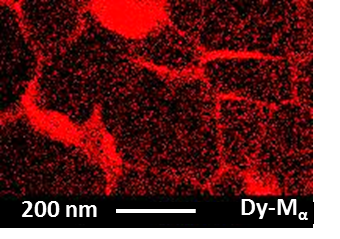
Grain boundary diffusion in nanocrystalline Nd-Fe-B permanent magnets with low-melting eutectics
Simon Sawatzki, Christian Kübel, Semih Ener, Oliver Gutfleisch
Acta Mater. 115 (2016) 354-363
In order to combine the good thermal stability of nanocrystalline Nd-Fe-B magnets with the efficient grain boundary diffusion process (GBDP), low-melting eutectics have been mixed with Nd-Fe-B melt-spun ribbons, hot-compacted and subsequently die-upset. Transmission electron microscopy (TEM) analysis revealed the formation of 5-10 nm thick Dy-shells and a crystallography dependent diffusion into the individual solid grains on the nanoscale. Subsequent annealing at 600°C leads to an enhanced diffusion but also some undesired Nd-O phases and induced grain growth depending on the annealing time, degree of deformation, strain rate and position within the sample. An optimized distribution of the low-melting eutectic was realized by milling the precursor powder and by using ternary alloys with reduced melting points. As a consequence a much higher effective increase in coercivity per wt%Dy was obtained compared to a homogeneous Dy-distribution which demonstrates the validity of this new approach.
Contradictory role of the magnetic contribution in inverse magnetocaloric Heusler materials
T. Gottschall, K. P. Skokov, D. Benke, M. E. Gruner, O. Gutfleisch
Phys. Rev. B 93, 184431 (2016)
In this paper, we illustrate the dilemma of inverse magnetocaloric materials using the example of Heusler alloys. For the two paradigmatic Heusler systems of Ni-Mn-In and Ni-Mn-In-Co, we provide a systematic comparison of experimental data under different magnetic fields and hydrostatic pressures with magnetic and the magnetocaloric properties obtained from the Heisenberg model. This allows us to separate the lattice and the magnetic contribution to the total entropy of the martensitic transition. Our analysis reveals that a large magnetization change is parasitic, but at the same time it is necessary to drive the magnetocaloric effect. This contradicting role of the magnetic contribution – the dilemma – is a general characteristic of inverse magnetocaloric Heusler materials.
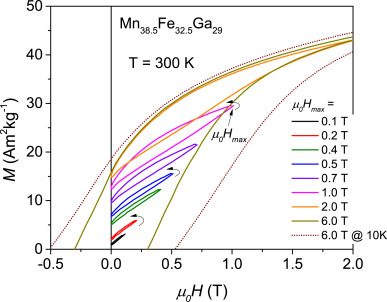
The search for room temperature tetragonal phases of Fe-Mn-Ga: A reactive crucible melting approach
Semih Ener, Johannes Kroder, Konstantin P. Skokov, Oliver Gutfleisch
Journal of Alloys and Compounds 683, 198 (2016)
A bulk high-throughput screening method is needed for the experimental search of new permanent magnet materials. In this work, the fast, easy and effective reactive crucible melting method was applied to the Ni-Mn-Ga and Fe-Mn-Ga Heusler systems. Energy dispersive X-ray spectroscopy was used for elemental analysis of phases formed in the crucibles which allowed us to construct parts of the room-temperature phase diagrams of Ni-Mn-Ga and Fe-Mn-Ga systems. By means of magneto-optical Kerr microscopy the phases with stripe domains – an essential feature of an uniaxial magnetic anisotropy – were identified and synthesized by conventional metallurgy. The structural/microstructural properties of the synthesized individual sample were investigated in addition to the magnetic properties. A high room temperature coercivity value of 0.33 T is obtained which is comparable with Alnico permanent magnets.
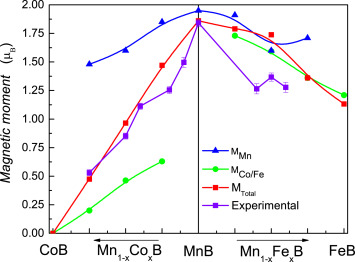
Monoborides doped with iron and cobalt for thermomagnetic generators
M. Fries, Z. Gercsi, S. Ener, K. P. Skokov, O. Gutfleisch
Acta Mater. 113, 213 (2016)
A systematic study focusing on the crystallographic, magnetic and magnetocaloric properties of cobalt and iron substituted MnB was conducted. The pure MnB sample shows a sharp magnetic transition of 567 K yielding a large magnetic entropy change in a 2 T field change. It is shown that both the substitution of Co and Fe elements for Mn were found to effectively modify Tc accompanied by a lower magnetization leading to a reduced magnetocaloric effect. The differences in magnetic properties with substitution are described by calculation of the density of states and interatomic distances. The sharp and significant change of Ms(T), the very stable nature of these refractory borides and abundant availability makes some of these compositions suitable for thermomagnetic power generation applications.
Dynamical Effects of the Martensitic Transition in Magnetocaloric Heusler Alloys from Direct ΔTad Measurements under Different Magnetic-Field-Sweep Rates
T. Gottschall, K. P. Skokov, F. Scheibel, M. Acet, M. Ghorbani Zavareh, Y. Skourski, J. Wosnitza, M. Farle, O. Gutfleisch
Phys. Rev. Applied 5, 024013 (2016)
Large magnetocaloric effects can be obtained in Ni-Mn-based Heusler alloys due to the magnetostructural transition between martensite and austenite. This phase transformation proceeds via nucleation and growth. By direct measurements of the adiabatic temperature change ΔTad using different magneticfield-sweeping rates from 0.01 up to 1500 Ts−1, we study the dynamic behavior of the two Heusler compounds Ni50Mn35In15 and Ni45Mn37In13Co5 transforming near room temperature. From these experiments, we conclude that the nucleation process is rather slow in contrast to the relatively fast movement of the phase boundary between martensite and austenite.
On the S(T) diagram of magnetocaloric materials with first-order transition: Kinetic and cyclic effects of Heusler alloys
Tino Gottschall, Konstantin P. Skokov, Ramon Burriel, Oliver Gutfleisch
Acta Mater. 107, 1 (2016)
In this work we investigate the reversible magnetocaloric effect of Heusler alloys under cycling in terms of the S(T) diagram. For this purpose we selected three different Heusler alloys of NieMneIn with transition temperatures between 200 k and room temperature. The S(T) diagrams of the three materials cover all conceivable shapes and are therefore representative for inverse magnetocaloric Heusler alloys. First we comprehensively analyzed the magnetocaloric properties of this model system using calorimetry, magnetometry and direct measurements of the adiabatic temperature change ΔTad and subsequently combined those results into the S(T) diagram.
PhD-graduation in the FM group
We congratulate our dear colleague Simon Sawatzki to his excellent doctoral work on the “Grain boundary diffusion process in nanocrystalline Nd-Fe-B permanent magnets”, which was rewarded by the PhD commission with highest honor (summa cum laude). We thank him for all his contributions going beyond his project work and the memorable day of his defense! We are glad that he will continue his research in our group.
Parts of his work are already published in journals and can be downloaded from our webpage:
Funktionale Materialien/Publications
The full dissertation is available via ULB Darmstadt
IEEE Distinguished Lecture: Ludwig Schultz
We thank Prof. Dr. Ludwig Schultz from the IFW Dresden/ TU Dresden for his visit and his lecture on the “Interaction of ferromagnetic and superconducting permanent magnets – superconducting levitation” given on the 4th of December 2015.
Magnetic anisotropy of La2Co7
M.D. Kuz'min, K.P. Skokov, I. Radulov, C.A. Schwöbel, S. Foro, W. Donner, M. Werwiński, J. Rusz, E. Delczeg-Czirjak, and O. Gutfleisch
J. Appl. Phys. 118 (2015) 053905
The magnetic properties as well as the crystal structure of La2Co7 single crystals were investigated. The compound has an easy-axis anisotropy with a K1 as high as 2 MJ/m3 (at a maximum near T = 100 K) and a K2 that is much lower than K1. The anisotropy field amounts to 8 T at T = 10K and 6.7 T at room temperature. A significant (10%) magnetization anisotropy has been observed. Density-functional calculations by our partners at Uppsala University are in very good qualitative agreement with experiment.
http://dx.doi.org/10.1063/1.4927849
Effect of doping by 5d elements on magnetic properties of (Fe1−xCox)2B alloys,
PHYSICAL REVIEW B 92 (2015) 174413
A. Edström, M. Werwinski, J. Rusz, O. Eriksson, K.P. Skokov, I.A. Radulov, S. Ener, M.D. Kuz’min, J. Hong, M. Fries, D. Yu. Karpenkov, O. Gutfleisch, P. Toson , J. Fidler
We investigated the magnetic properties of the (Fe1−xCox)2B alloys both experimentally and computationally. Using DFT calculations showed the effect of substitutional doping the transition metal sublattices by 5d transition metals. The theoretical predictions agree well with the experimental observations on eg Ir and Re substituted single crystals. Doping by 2.5 at.% of Re on the Fe/Co site shows a magnetocrystalline anisotropy energy which is increased by 50% compared to its parent (Fe0.7Co0.3)2B compound, making this system interesting in the context of permanent magnet replacement materials.
Annual group meeting
07.09.15-09.09.15 the annual group meeting took place at the Seminarhotel Kurhaus Trifels, giving everybody the opportunity to present and discuss their results and achievements obtained in the last year. To balance activities, a hike to the castle of Trifels was scheduled in the afternoon in the best sunshine that one could expect from the early September weather. The excellent cuisine that included a great barbeque provided the best support for body and spirit. The nice seminar rooms, refreshments and snacks made sure that motivation was always high. While it was a great group experience for the whole team, many fruitful ideas sparked as the result of discussions and future perspectives.
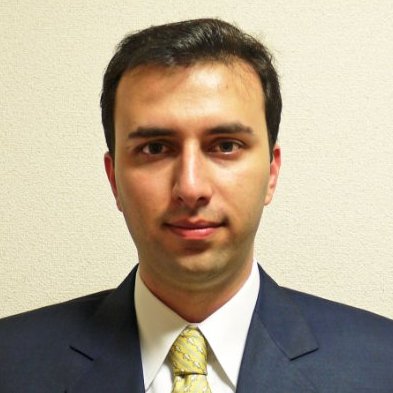
Visit of Dr. Sepehri-Amin from NIMS Tsukuba
Dr. Sepehri-Amin from Magnetic Materials Unit, National Institute for Materials Science – NIMS, Tsukuba, Japan, works on the development of Dy-free high performance Nd-Fe-B permanent magnets via microstructure design and modification. We are happy to say that he is visiting our Functional Materials group for one month within the RESPONSE LOEWE excellence programme. During his stay he gave seminar talks on 3rd of July in Darmstadt and on 7th of July at Fraunhofer IKWS Alzenau on his recent works. Further cooperation is planned on Dy-free Nd-Fe-B permanent magnets.
European Rare Earths Competency Network (ERECON)
Rare earth elements are a group of 17 speciality metals used in high-tech products such as smart phones or wind turbines. Due to the lack of internal supply the EU needs to import more than 90 % of these metals, mainly from China. As the demand for rare earths is expected to grow, the EU aims to improve access to these metals, reduce their consumption and improve extraction conditions in Europe. To help secure the supply, the European Rare Earths Competency Network (ERECON) was established.
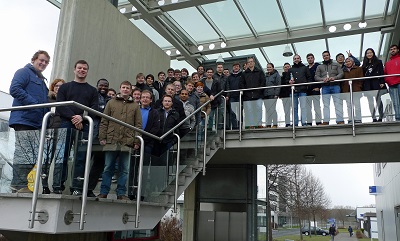
Visit to Heraeus Quarzglas GmbH & Co. KG
02.02.2015 Within the lecture course “Materials Engineering” we visited Heraeus Quarzglas GmbH & Co. KG in Kleinostheim. The students, who are in their first master semester, were able to get an insight into Heraeus’ production line, which included continuous casting and glass forming facilities. Additionally, the students could deepen their understanding of glass technology in two presentations about quartz glass and infrared heating devices.
We thank Heraeus for the hospitality and excellent organization of our excursion.
PhysRevLett: Element-Resolved Thermodynamics of Magnetocaloric LaFe13−xSix
M.E. Gruner, W. Keune, B. Roldan Cuenya, C. Weis, J. Landers, S. Makarov, D. Klar, M. Y. Hu, E.E. Alp, J. Zhao, M. Krautz, O. Gutfleisch, H. Wende
Together with the University Duisburg-Essen the element-resolved vibrational density of states across the first-order transition from the ferromagnetic
low temperature to the paramagnetic high temperature phase of LaFe13−xSix was investigated. We found that the increase in lattice entropy associated with
the Fe subsystem is significant and contributes cooperatively with the magnetic and electronic entropy changes to the excellent magneto- and barocaloric properties.
Visit of Hessian Minister of Environment Mrs. Priska Hinz
31.01.2015 Within the Week of Science the Hessian Minister of Environment Mrs. Priska Hinz visited the LOEWE research cluster RESPONSE at the Technische Universität Darmstadt. Up to now the rare earth elements (REE) have no adequate substitutes in many high tech applications, especially high performance permanent magnets for wind turbines and electro-mobility are difficult to replace by magnet materials using less critical elements. Additionally, the beneficiation of the REE from their ores has a high environmental impact which puts a question mark behind the sustainability of some novel energy technologies. The RESPONSE project is dedicated to the drastic reduction and complete substitution of REE in permanent magnets. During her visit the Minister visited the labs, was updated on current research activities, followed by discussions about future strategic goals.
Large reversible magnetocaloric effect in Ni-Mn-In-Co
Tino Gottschall, Konstantin P. Skokov, Bianca Frincu and Oliver Gutfleisch
Appl. Phys. Lett. 106, 021901 (2015)
We report on the high irreversible adiabatic temperature change of −8 K in a magnetic field change of 1.95 T in the Heusler compound Ni45.7Mn36.6In13.5Co4.2 showing a first-order magnetostructural transition. Due to the large thermal hysteresis of 10 K, this high ΔTad cannot be obtained in a cyclic way but still the reversible magnetocaloric effect amounts to −3 K—an unexpectedly high value which compares to the ΔTad of La(Fe,Si,Co)13. In order to reveal the nature of this high reversible magnetocaloric effect, in-situ temperature dependent optical microscopy of minor loops of thermal hysteresis has been done.
Mechanism of the texture development in hydrogen-disproportionation–desorption-recombination (HDDR) processed Nd–Fe–B powders.
Sepehri-Amin, H. ; Ohkubo, T. ; Hono, K. ; Güth, K. ; Gutfleisch, O.
Microstructure evolution in Nd12.8Fe80.1B6.6Ga0.3Nb0.2 alloy powders at different hydrogen pressures during the hydrogen-disproportionation process has been studied. Transmission electron microscopy showed that Fe2B grains “memorize” the
crystallographic orientation of the initial Nd2Fe14B phase and transfer it to the recombined Nd2Fe14B grains in the highly textured sample. 3-D tomography of backscattered electron SEM images showed that recombined Nd2Fe14B grains nucleate at the interfaces of Fe2B/NdH2 phases, which grow through the interfaces of NdH2/a-Fe phases during the DR process.
A new type of La(Fe,Si)13 based magnetocaloric composites with amorphous metallic matrix
Krautz, Maria ; Funk, Alexander ; Skokov, Konstantin P. ; Gottschall, Tino ; Eckert, Jürgen ; Gutfleisch, Oliver ; Waske, Anja
This work shows a promising route for the production of compact refrigerant bodies consisting of brittle giant magnetocaloric materials whose performance are often affected by their mechanical integrity. Hot compaction at the glass transition temperature, Tg, of the amorphous matrix prevents crack formation as commonly occurs in conventional hot-compacted La(Fe,Si)13 material.
Visit to UMICORE
Within the lecture „Materials Engineering“ in the Master course Material Science at TUDA we visited on 15th of December 2014 Umicore AG & Co. KG in Hanau, Hessen. The students were able to get an insight into Umicore‘s production line of Nickel-based contact materials as well as facilities for the recycling of precious metals like e.g. Silver.
MOOC@TU9
MOOC@TU9 presents the wide variety and different perspectives of German engineering courses at TU9 universities, and offers insights into the central issues, contents, structures and work methods of the various disciplines and courses of study. Join us for nine weeks and discover what Excellence in Engineering and the Natural Sciences – Made in Germany at TU9 is all about. Week 5 is about: Models in Material Engineering – From Devices for Nanotechnology to New Magnetics.
Prof. Oliver Gutfleisch explains: Magnetic Materials for green technologies
Permanent magnets are essential materials for everyday life. Every one of us possesses numerous magnets without necessarily being aware of them as they are hidden in computers, speakers, smart phones or also in modern cars in which at least 50 magnets can be found. However, they are also key components in upcoming energy technologies such as windturbines and electromobility. In the session you will learn more about rare earth elements and how modern magnets benefit of their unusual physical and chemical properties. The most important facts about permanent magnets will be discussed and also a critical reflection on the sustainability of rare earth elements and with this the vulnerability of technologies will be part of the session.
Meeting with Japanese delegation of MagHEM
On November 20th we received a Japanese delegation of MagHEM (Technology Research Association of Magnetic Materials for High-Efficiency Motors) contracted with NEDO (New Energy and Industrial Technology Development Organization) funded by METI (Ministry of Economy, Trade and Industry), which is aiming at development of high-performance magnetic materials without rare-earth and high-efficiency motors. All major Japanese magnet producers and major automotive and automotive parts OEMs were represented. Information on common research interests such as in LOEWE Response were exchanged.
High energy product in Battenberg structured magnets
Bance et al., Influence of defect thickness on the angular dependence of coercivity in rare-earth permanent magnets, Applied Physics Letters, Volume 104, 2014, Pages 182408ff
In the paper we present results from micromagnetic simulations that assess the performance of multi-phase nanostructured permanent magnets, whose cross-section resemble that of a Battenberg cake. By including a super-hard outer shell we are able to counteract the effects of thermal fluctuations and surface defects, both of which are detrimental to the performance of such permanent magnets. Such magnets are important for the motors in electric vehicles and for the generators in wind turbines, and these machines usually operate at elevated temperatures
Temperature-dependent Dy diffusion processes in Nd–Fe–B permanent magnets
Löewe, K. ; Brombacher, C. ; Katter, M. ; Gutfleisch, O.
Nd-Fe-B permanent magnets have been coated with Dysprosium and annealed at various temperatures to study the impact of the temperature dependent Dy diffusion processes on both the magnetic properties and the microstructure. When optimum annealing conditions are applied the improved stability against opposing magnetic fields can be observed in the magnets up to a depth of about 3 mm along the diffusion direction.
After the diffusion treatment, the specific “core-shell” microstructure has been investigated with WDX and STEM EDX. While in the proximity of the Dy – coated surface, each grain has a Dy enriched shell with a Dy – content of around 6 at.%, the Dy concentration decreases exponentially to about 1.8 at.% after a diffusion depth of 400 µm and to about 1 at.% after a diffusion depth of 1500 µm.
An epitaxial relation between Dy – poor core and Dy – rich shell was observed by EBSD. This finding is supported by results obtained with Kerr microscopy.
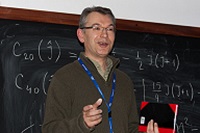
Prof. Michael Kuzmin
We congratulate our group member Michael Kuzmin to his professorship at the University of Marseille, starting on 1 st of September 2014.
Visit of Prof. Victorino Franco
We welcome Prof. Victorino Franco from Universidad de Sevilla, to our group of Functional Materials for the time of two months. Till end of October 2014 he will stay with us, working on magnetocaloric materials.
Wissenschaftsminister überreicht Förderbescheide
Im Zentrum steht das LOEWE-Projekt zur Schonung seltener Erden
Der hessische Wissenschaftsminister Boris Rhein hat am 05. Juni bei einer Feierstunde an der TU Darmstadt Fördergelder in Höhe von rund sieben Millionen Euro aus der LOEWE-Initiative zur Förderung exzellenter Forschung übergeben – sie gehen an die TU Darmstadt und an drei hessische Unternehmen.

DGM-Fachausschuss Funktionsmaterialien gegründet
Am 23. Mai 2014 kamen etwa 60 interessierte Materialwissenschaftler und Werkstofftechniker zur konstituierenden Sitzung zum neuen Fachausschuss „Funktionsmaterialien“ der Deutschen Gesellschaft für Materialkunde (DGM) an der TU Darmstadt, Fachbereich Materialwissenschaft, zusammen. Prof. Dr. Gutfleisch als Sprecher des FA eröffnete die Sitzung. Teilnehmer waren sowohl Studenten, Doktoranden und Hochschulprofessoren als auch Vertreter aus der Industrie.
G8 Project Workshop at TU Darmstadt
On May 9th, 2014 the second Workshop of the G8 Project was held at Technical University of Darmstadt. Partners from US, Japan and Germany attended the meeting, presenting their latest studies on the topic of “Rare-earth Free Permanent sustainable for the Next Generation”. Prof. Gutfleisch (TUDA) opened the meeting and was followed by Prof. Suzuki (MINT – University of Alabama) who presented the recent experimental results on MnAl and MnBi thin films. Dr. Sepehri-Amin (NIMS) presented the microstructure analysis on the MnAl, MnBi and MnRh thin films. Magnetic properties of melt-spun ribbons and mechano-chemically synthesized MnBi and MnGa were presented by Prof. Hadjipanayis (University of Delaware). Dr. Göring from the Max Planck Institute Stuttgart presented the recent XMCD studies on MnBi samples. Presentations were completed by talks of M.Sc. Jian and Dr. Ener from Technical University of Darmstadt on bulk MnAlC and MnGa.

Moderne Rohstoffe – Raubbau oder Nachhaltigkeit?
Chancen und Risiken für unsere Gesellschaft
Seltene Erden, Phosphor und Wertschöpfungskette: Im Rahmen eines Universitätstags erörtern Experten die Verfügbarkeit und den Gebrauch von modernen Rohstoffen – zum Beispiel aus umwelt- und volkswirtschaftlicher Sicht. Rohstoffe sind für Gesellschaft und Wirtschaft unverzichtbar, ihre Verfügbarkeit beeinflusst zukünftige Technologieentwicklungen.
(opens in new tab) here

hoch3 Forschen: “High-performance magnets”
In the current issue of the TU Darmstadt maganzin hoch3 Forschen Prof. Oliver Gutfleisch was interviewed on the topic of permanent magnetic marterials. The whole issue can be downloaded free of charge
Opening ceremony of our new building M3
The name of the new building M3is an acronym for “magnets, molecules and materials” which are the research topics of the scientists from the department of Chemistry and Materials Science who moved in recently. On 29 October 2013 the new laboratory and office building was presented to the public by a festive opening.

IEEE Distinguished Lecture: Rudolf Schäfer
On 21 October the IEEE Distinguished Lecturer Rudolf Schäfer from IFW Dresden visited the TU Darmstadt to present his lecture about “Magneto-Optic Analysis of Magnetic Microstructures”.
Electrical and magnetic properties of hot-deformed Nd-Fe-B magnets with different DyF3 additions
The effect of deformation and DyF3 additions on the electrical resistivity and the magnetic performance has been studied in hot-deformed Nd-Fe-B melt-spun ribbons and correlated with respective microstructures. Despite the nanocrystallinity of hot-compacted magnets, the specific electrical resistivity measured by four-point-method was shown to be comparable with that of sintered magnets. Die-upsetting reduces electrical resistivity within the hard plane because of an enhanced shape anisotropy of the grains. The addition of DyF3 overcompensates this reduction due to the presence of electrically insulating Dy-F rich inclusions and thus reduces eddy current losses within the magnet. Magnetic measurements reveal an increase in coercivity without a change in remanence for die-upset magnets with a total height reduction of 63% and 1.2 wt. % Dy (1.6 wt. %DyF3). Both properties demonstrate an effective reduction in heavy rare earth Dy for Nd-Fe-B magnets.
LOEWE application receives positive evaluation!
On 11 July 2013 the Hessian Ministry of Sciences approved the LOEWE application RESPONSE coordinated by Prof. Dr. Oliver Gutfleisch. RESPONSE deals with the reduction and substitution of rare earth elements in high performance permanent magnets. The research grant amounts to 4.4 million Euros for 3 years. RESPONSE complements the applied research on magnetic materials at Fraunhofer IWKS Hanau with fundamental studies at the university.
IEEE Distinguished Lecture: Koki Takanashi
We are pleased to announce that Prof. Koki Takanashi from Tohoku University, Japan, will give his IEEE Distinguished Lecture about “Advanced Spintronic Materials: For Generation and Control Of Spin Current” in Darmstadt on 10 July. The event will start at 3:00 pm in room L2|01 77.
First Group Seminar
In June the first internal seminar of the division of Functional materials was held in the monastery of Bronnbach (near Wertheim) where the Fraunhofer ISC has a branch. In the old vaults of this historical place the group discussed recent scientific result and focused on future activities.
Workshop on “Energy and Materials Criticality”
It is our pleasure to announce the Workshop on “Energy and Materials Criticality”, taking place on the beautiful Greek Island of Santorini, directly preceding JEMS, August 22nd through the 25th. The aim of this Workshop is to bring together world renown scientists and engineers to discuss current worldwide research on the reduction, substitution, and recycling of critical magnetic materials, and to encourage the international collaborations and interactions that would lead to a significant decrease in our dependence on these critical materials worldwide. Organized by George Hadjipanayis of the University of Delaware (U.S.), and Oliver Gutfleisch of TU Darmstadt (Germany), the workshop will feature invited and contributed presentations from around the globe. Abstracts can be submitted until June 28, 2013. Please visit our website for more information. It is our hope that many of you will wish to attend this workshop before going on to JEMS in Rhodes.
Good marks for Materials Science
In the most recent ranking of the Center for University Development (CHE), the department of Materials Science of the TU Darmstadt is part of the leading group of the national comparison in terms of overall study situation, supervision, completing within standard period of study and reputation of research. About 250 000 students of more than 300 universities participated in this vote.
European School on Magnetism 2013
Feb. 25th to Mar. 8th in Cargèse, France
The topic of the this year´s European School on Magnetism (ESM), coorganized by Prof. Oliver Gutfleisch, will be about Magnetism for energy. It will gather 100 participants coming mainly from Europe, with a few positions open to other countries. In within the 10 days of program, young researchers will have the opportunity to deepen their understanding of magnetism for a efficient scientific work and getting in to contact with the magnetic community.
Workshop on Hydrogen Storage
Feb. 19th at TU Darmstadt
Within the scope of the series of events entitled “Materialinnovationen in der Wasserstoff- und Brennstoffzellentechnologie” of the Hessian Ministry for the Environment, Energy, Agriculture and Consumer Protection, a workshop on Hydrogen is held, covering the topics of hydrogen production, storage and fuel cells. On February 19 the TU Darmstadt is host of the program part about Hydrogen Storage.
Visit to UMICORE
In the framework of our lecture „Materials Engineering“ we visited the Umicore AG & Co. KG in Hanau, Hessen. The students were able to get an insight into Umicore‘s production line of Nickel-based contact materials as well as facilities for the recycling of precious metals like e.g Silver.
The G8 Research Councils Initiative on Multilateral Research Theme:
Material Efficiency – A first step towards sustainable manufacturing
In this initiative we will focus on “High Performance Permanent Magnets sustainable for Next Generation”. The program is for three years, starting from September 2012 through September 2015. The total amount for funding is 1,241,000 Euro. The consortium is proposed to address the issues of scarce availability and high-cost materials in Permanent Magnets (PM) and to offer alternative solutions for these issues.
IEEE Distinguished Lecture: George C. Hadjipanayis
We are very pleased to announce that Prof. G. Hadjipanayis from the University of Delaware, USA, will give his IEEE Magnetics Society distinguished lecture “Science and Technology of Modern Permanent Magnet Materials” in our institute on 12 December. Time and location will be notified in time.
Sabbatical Prof. Toshiyuki Shima
We welcome Prof. Toshiyuki Shima from Tohoku Gakuin University, Sendai, to our group of Functional Materials for the time of his sabbatical. Till August 2013 he will stay with us, working on hard magnetic thin films.
IEEE Distinguished Lecture: Masahiro Yamaguchi
30 August 2012: Our sincere thanks go to Prof. M. Yamaguchi from Tokyo University for following our invitation to give his IEEE lecture “Soft Magnetic Thin Film Applications at Radio Frequencies” in our department (From left to right: Prof. V. Khovaylo (MISIS Moscow), Prof. O. Gutfleisch, Prof. M. Yamaguchi, Dr. K. Skokov, T. Gottschall and Prof. S. Taskaev (Chelyabinsk State University)).
Opening of IWKS Hanau
On the 29th of June 2012 the second location of the newly founded Fraunhofer group IWKS on Materials Recycling and Resource Strategies was opened in Hanau. Professors Armin Reller from Augsburg, Stefan Gäth from Giessen and Oliver Gutfleisch from Darmstadt will lead the activities on resource strategies, recycling and substitution of critical materials.
European Raw Materials Group Breakfast
The second European Raw Materials Group Breakfast on 10 July 2012 was hosted by MEP Reinhard Bütikofer and focused on the situation regarding the rare earth elements and their state-of-play regarding R&D in Europe. O. Gutfleisch gave a key note lecture on “Rare Earth Elements for Energy Applications – Challenges for Research and Policy Makers”.
The Second Trilateral EU-Japan-U.S. Conference on Critical Materials
- Workshop on Substitute, Reduce, Resource and Recycle of Rare Earth Elements –
28./29. March 2012, Tokyo, Japan
The European Commission organized the event together with the US Department of Energy and the Japanese New Energy and Industrial Technology Development Organization (NEDO) on Research on Critical Materials and in particular on Rare Earth Magnets and their connection to a clean energy future. The trilateral conference dealt with New approaches to Reduce Rare Earths for Permanent Magnets and Phosphors and Environmentally sound, economical separation processes for rare earths in diverse ore bodies and recycling streams. Oliver Gutfleisch presented a perspective on the topic “Beyond NdFeB sintered magnets”.
Viewpoint Set No. 51: Magnetic Materials for Energy
Edited by Oliver Gutfleisch and Victorino Franco
This Scripta Materialia viewpoint set on Magnetic Materials for Energy provides opinionated articles by well-known experts in the field on the perspectives of hard and soft magnets as well as magnetocaloric materials for energy applications.
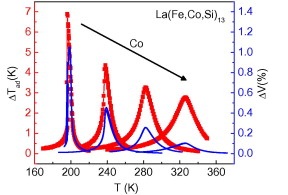
Exploring La(Fe,Si)13-based magnetic refrigerants towards application
Advanced magnetic refrigerants such as La(Fe,Si)13 materials require large entropy and adiabatic temperature changes based on the control of phase change physics and hysteresis. In order to advance their incorporation in prototypes and industrial applications, processing of single phase materials with graded working temperatures needs to be up-scaled and important engineering properties such as the thermal transport properties, corrosion protection and mechanical stability need to be optimized. These issues, including a last step of near net-shaped manufacturing of complex geometries, are discussed in this Viewpoint paper.
Giant magnetocaloric effect driven by structural transitions
Magnetic cooling could be a radically different energy solution substituting conventional vapour compression refrigeration in the future. We report now for Heusler-type Ni–Mn–In–(Co) magnetic shape-memory alloys, the adiabatic temperature change ΔTad = -3.6 to -6.2 K under a moderate field of 2 T. A phenomenological model is established that reveals the parameters essential for such a large ΔTad. We also demonstrate that obstacles to the application of Heusler alloys, namely the usually large hysteresis and limited operating temperature window, can be overcome by using the multi-response to different external stimuli and/or fine-tuning the lattice parameters, and by stacking a series of alloys with tailored magnetostructural transitions.
The effect of the thermal decomposition reaction on the mechanical and magnetocaloric properties of La(Fe,Si,Co)13
We report on the influence of the Co content in the magnetocaloric system La(Fe,Si,Co)13 on the thermal decomposition (TD) reaction. In the course of the TD reaction, the magnetocaloric La(Fe,Si,Co)13 phase reversibly decomposes in the temperature range of 973-1073K into α-Fe(Co,Si) and the intermetallic LaFeSi phase, thus enhancing the machinability of the compound. The addition of Co significantly speeds up the reaction kinetics. With electron microscopy a lamellar microstructure has been found in the decomposed state, indicating a eutectoid-type phase reaction. The width of the lamellae is ∼26 nm in LaFe12Si and decreases with increasing Co content. We conclude that the addition of Co somehow decreases the lamellar spacing, which is the main reason for the enhanced TD kinetics.
Effect of carbon on magnetocaloric effect of LaFe11.6Si1.4 compounds and on the thermal stability of its hydrides
For application as magnetic refrigerant in a domestic fridge it is vital to increase TC near to the room-temperature range while simultaneously maintaining a large magnetocaloric effect. In this work we studied the effect of interstitial carbon on the microstructure and magnetocaloric effect in LaFe11.6Si1.4Cx (x = 0–0.4). Carbon leads to an increase in TC and a decrease of the thermal hysteresis width. For x > 0.2, the magnetic transition changes from first-order to second-order, with a corresponding reduction in magnetocaloric effect. Up to x =0.2 the magnetocaloric properties of the parent alloy La(Fe,Si)13 are improved. Furthermore, the carbon addition increases the thermal stability of hydrided LaFe11.6Si1.4Cx significantly and shifts the desorption temperature from about 460K to 500K-540K (x=0.1 and 0.2).
Magnetostructural transition and adiabatic temperature change in MnCoGe magnetic refrigerants
Crystal structure, structural and magnetic transitions were investigated in a series of MnCo0.95Gex (x = 0.95, 0.97, 1.0) alloys. A first-order magnetic transition was observed in MnCo0.95Ge0.97 with a large thermal and magnetic hysteresis, while the other two composition alloys undergo a second-order ferromagnetic transition. The adiabatic temperature change for MnCo0.95Ge0.97 strongly relies on the sample history (heating or cooling protocols) due to the competition of structural and magnetic transitions. The structural contribution works against the magnetic contribution to the total magnetocaloric effect.

